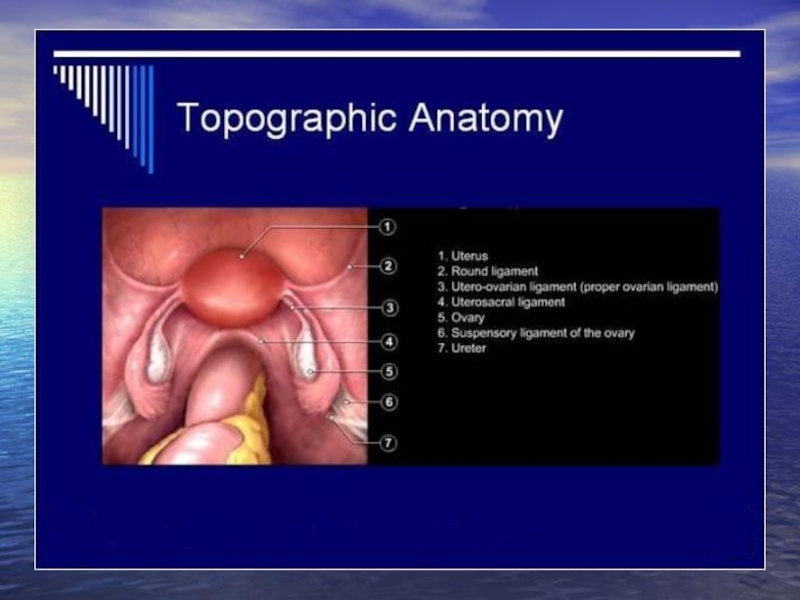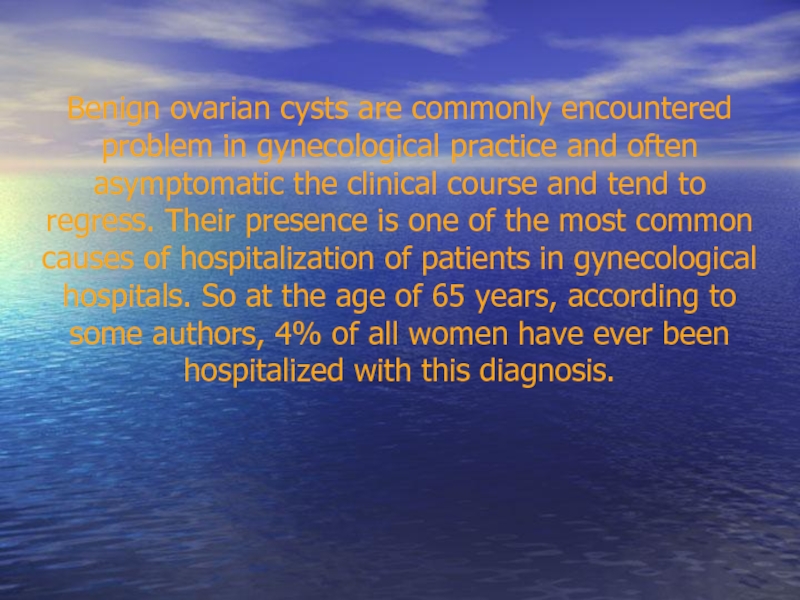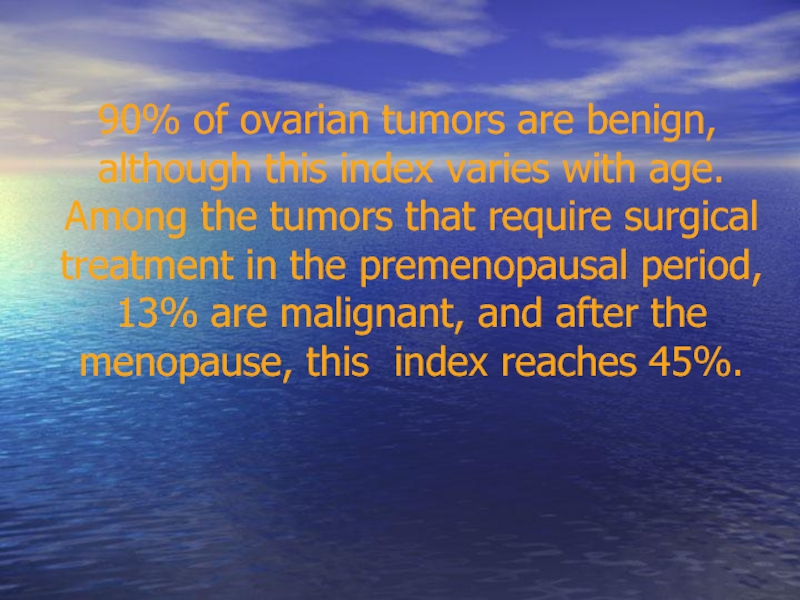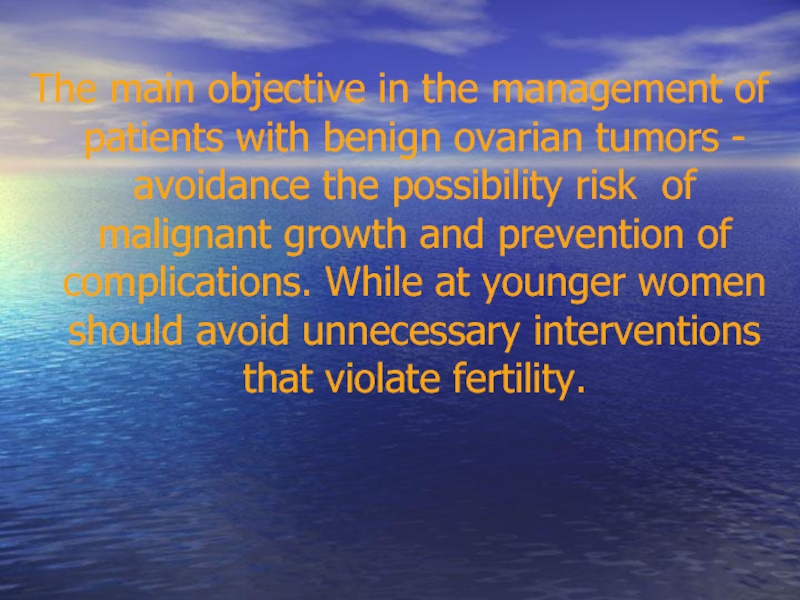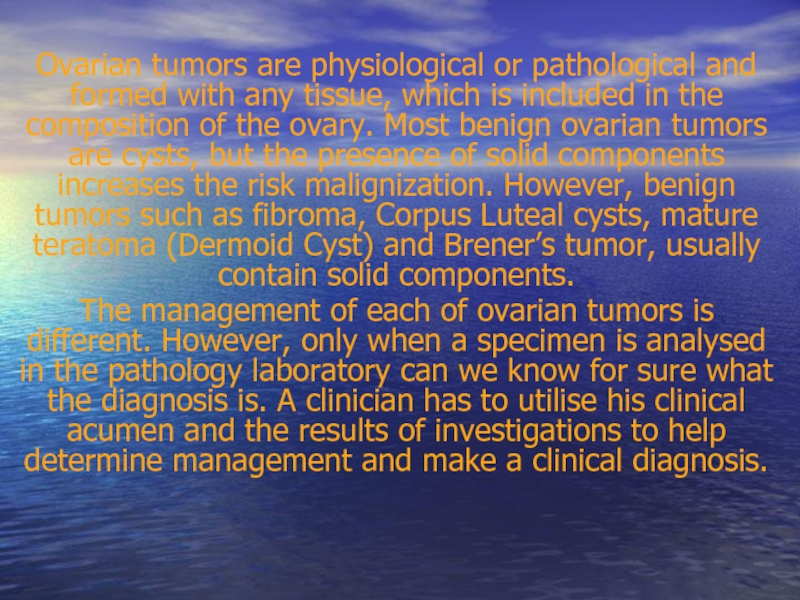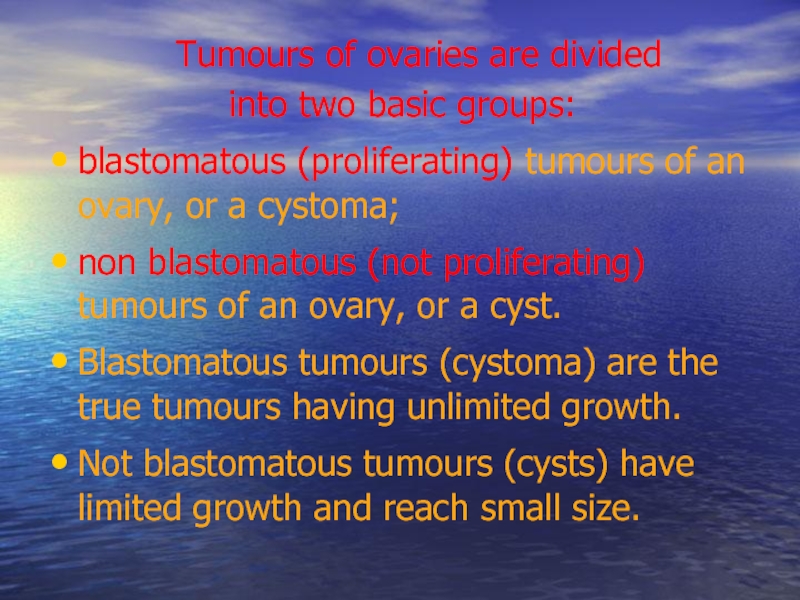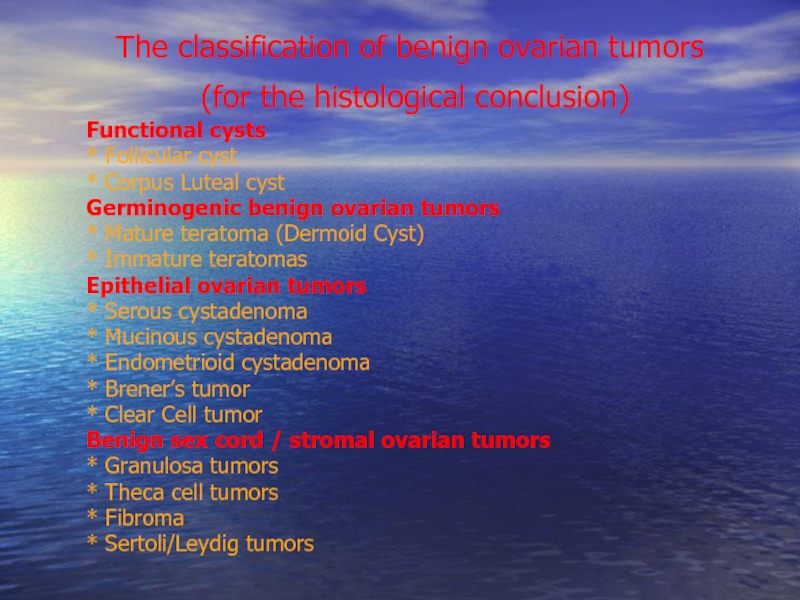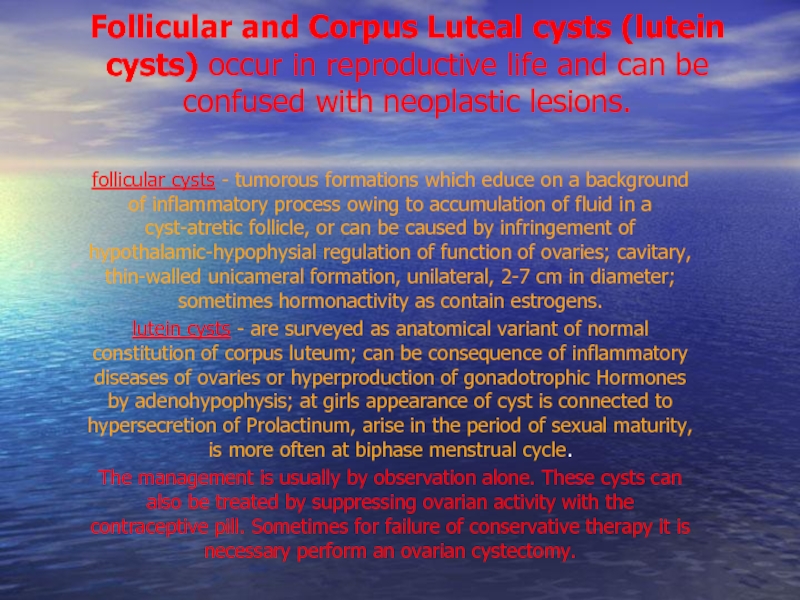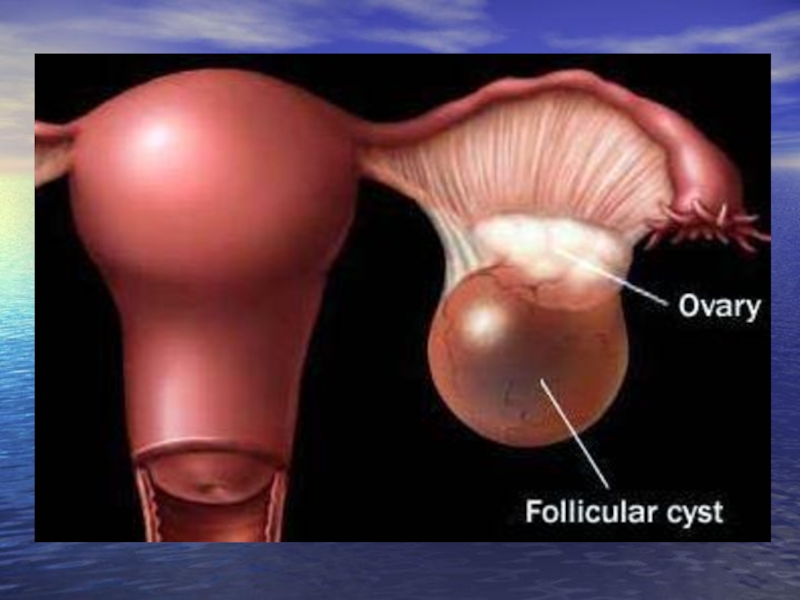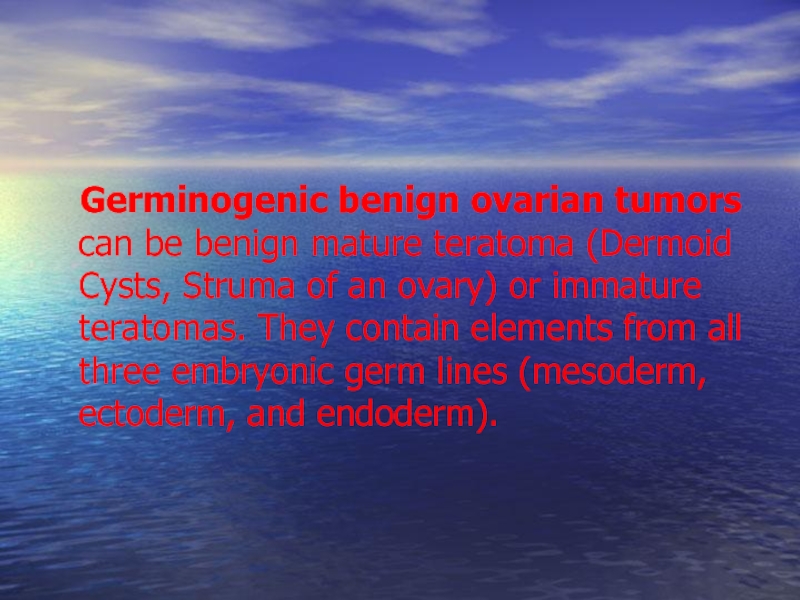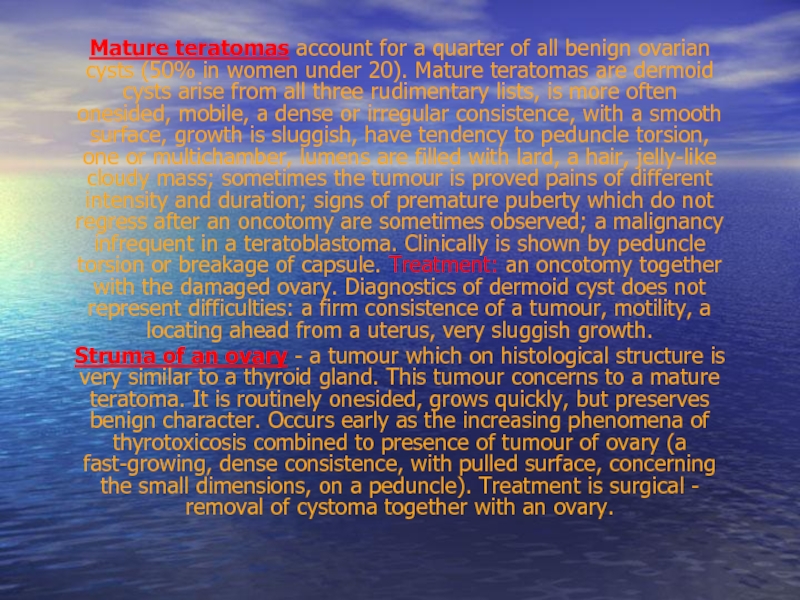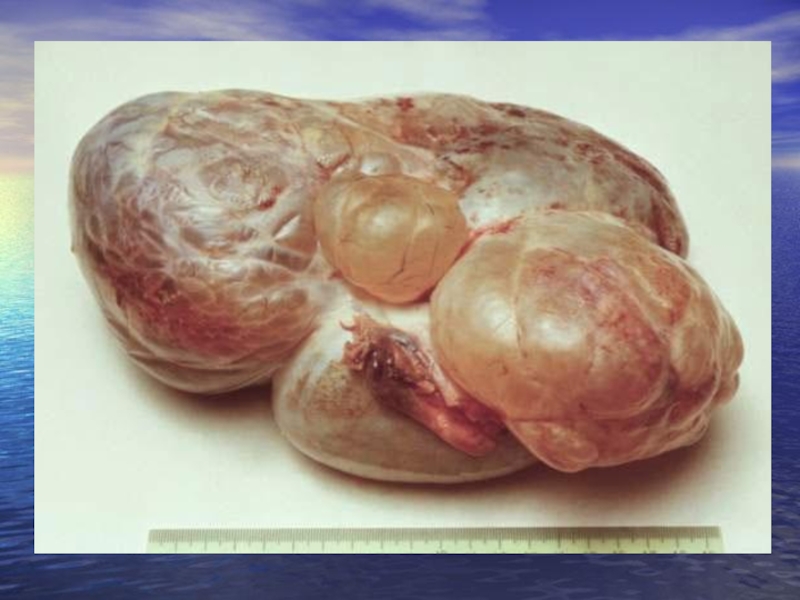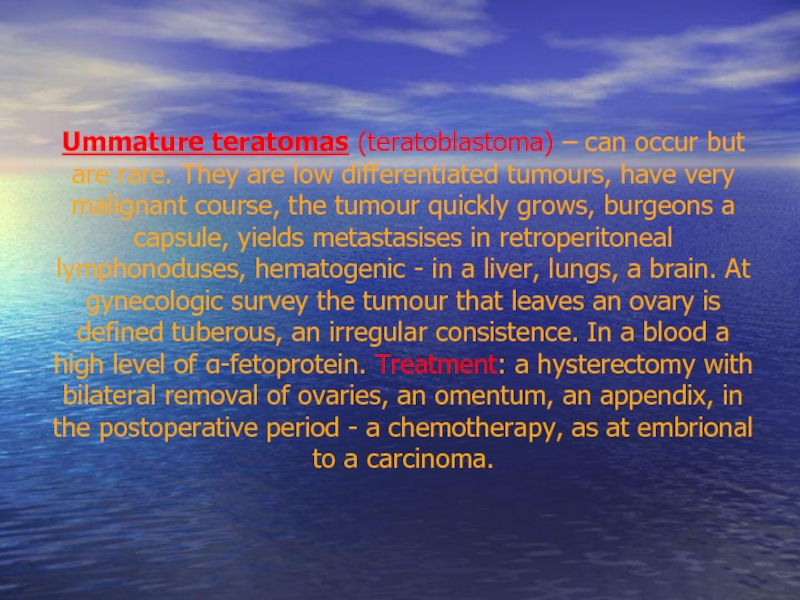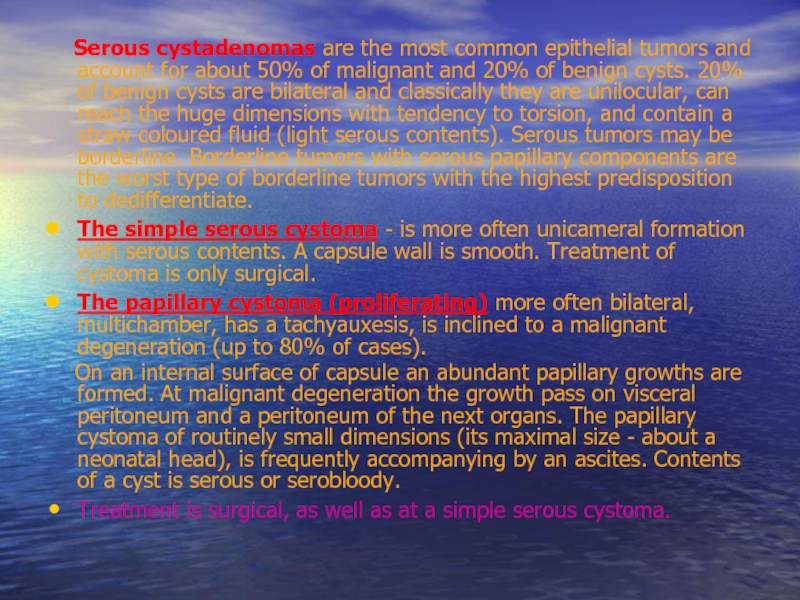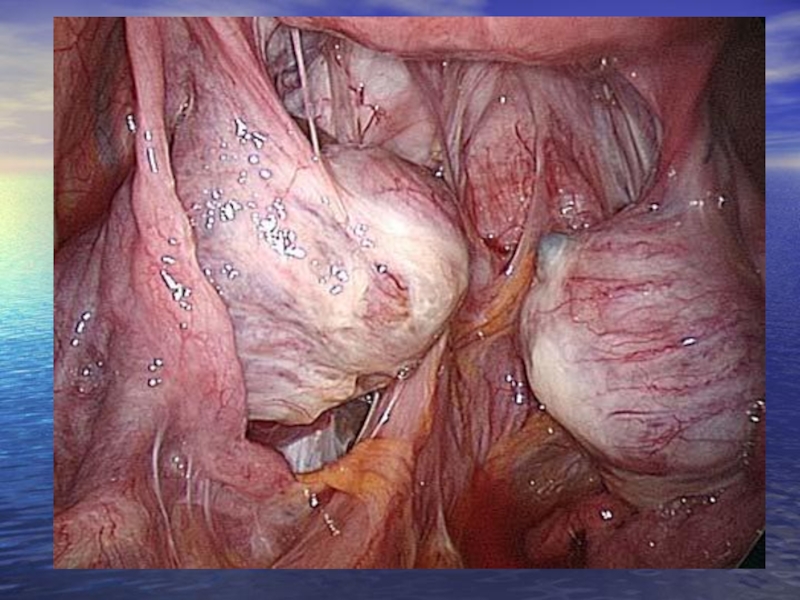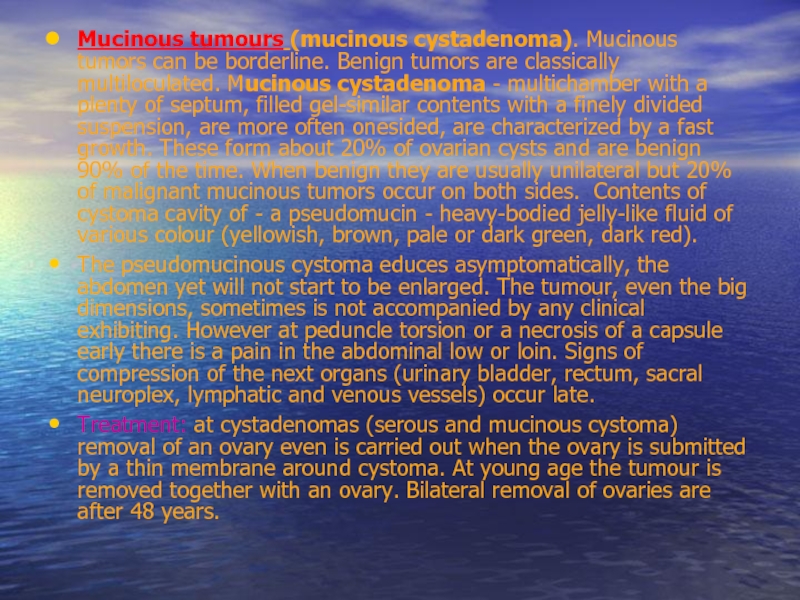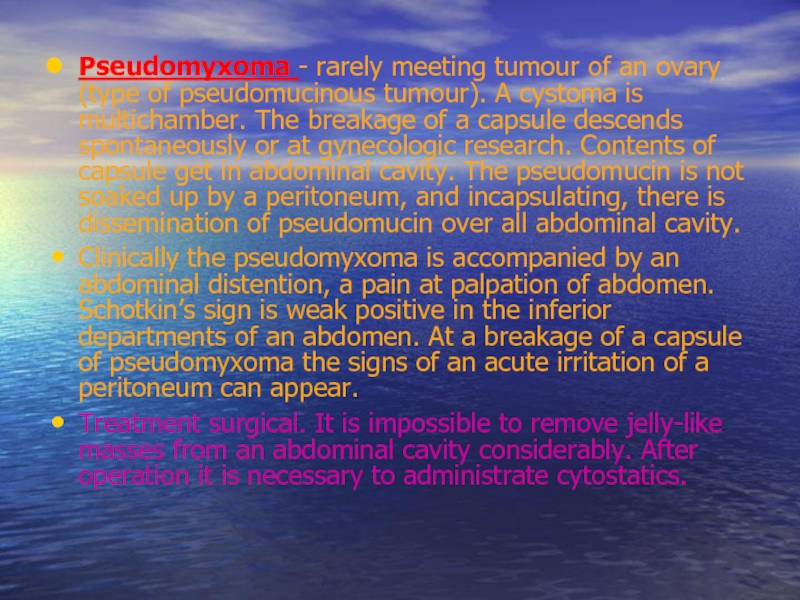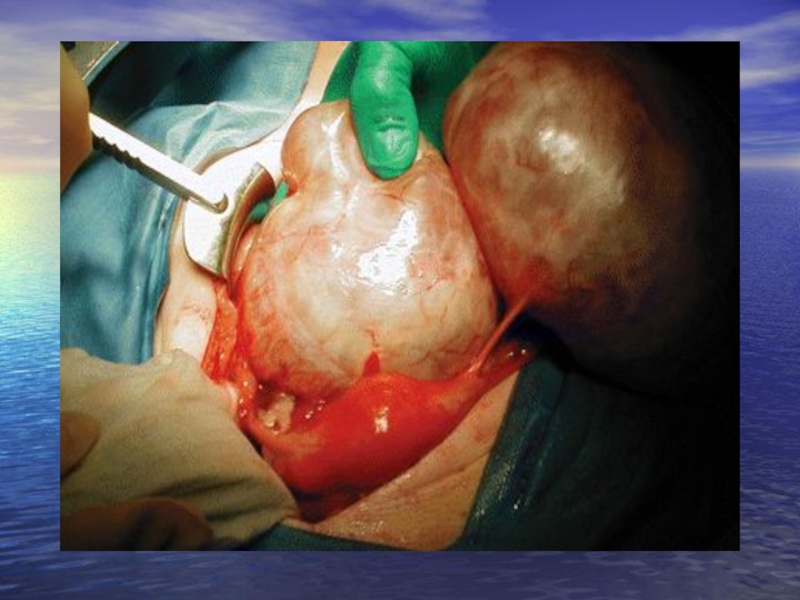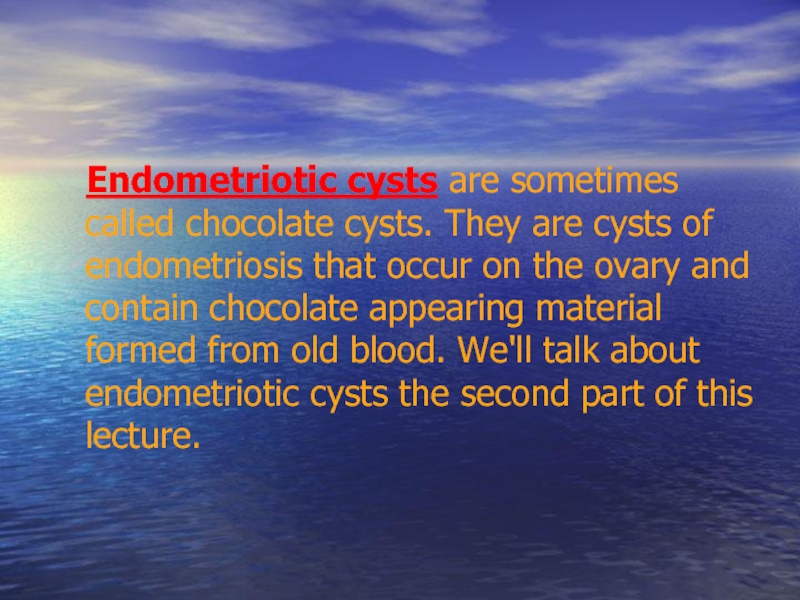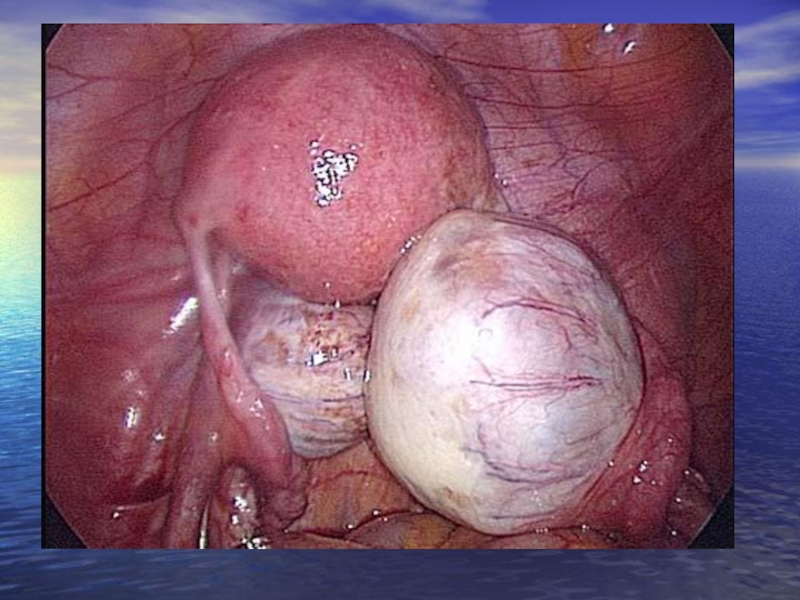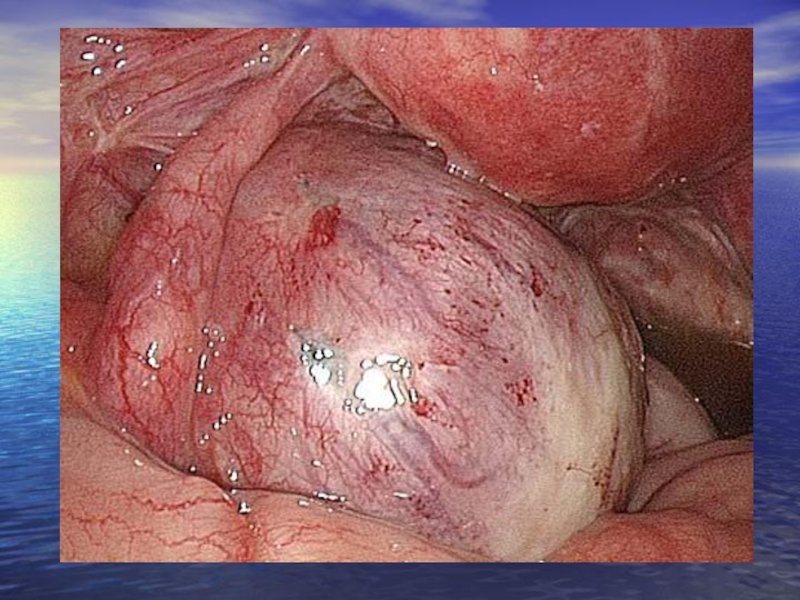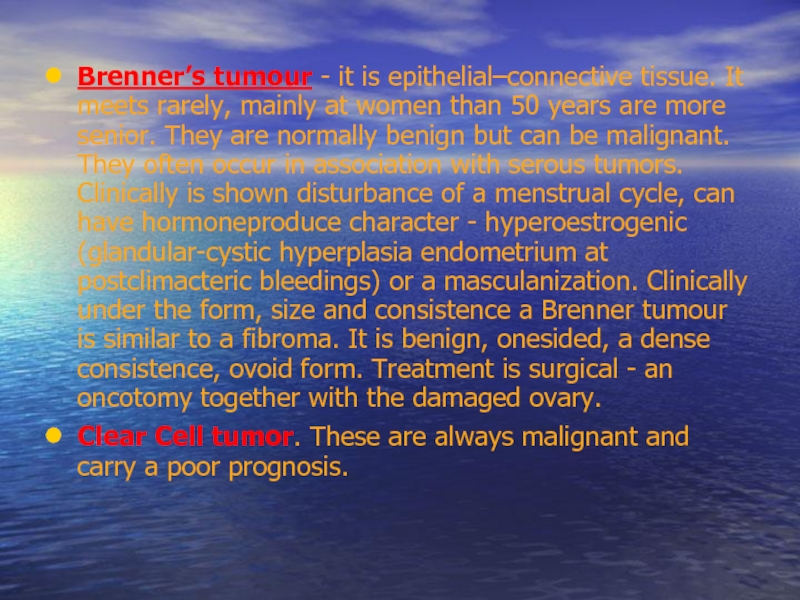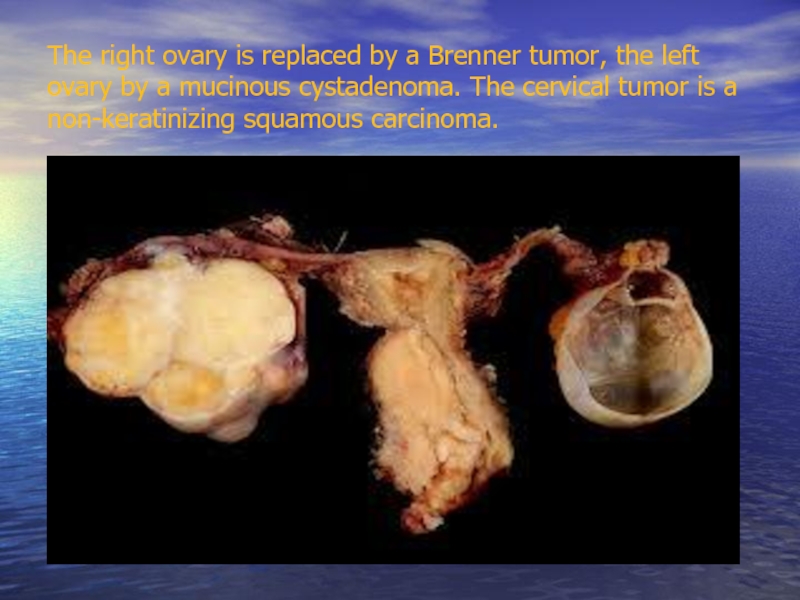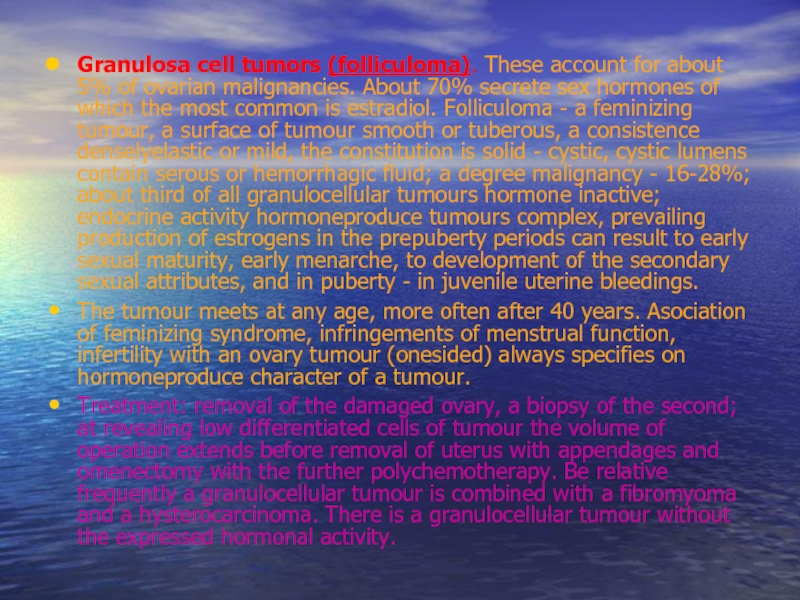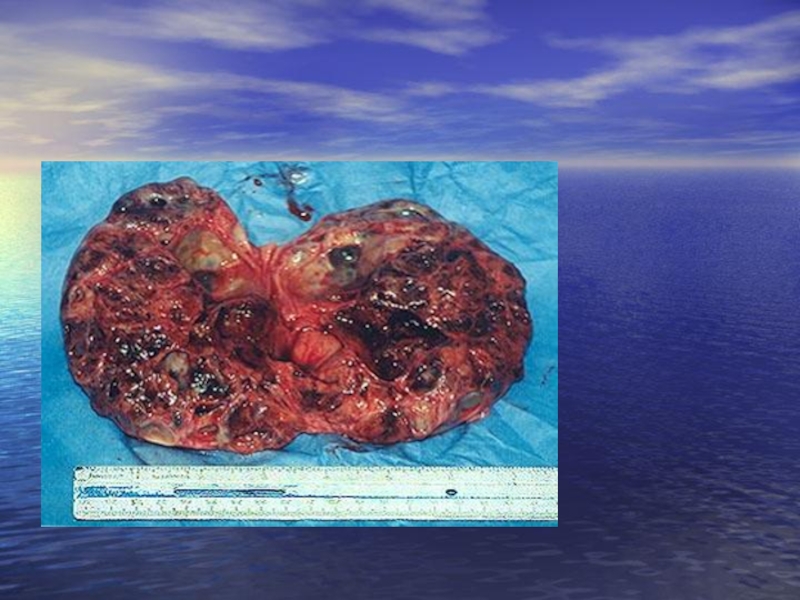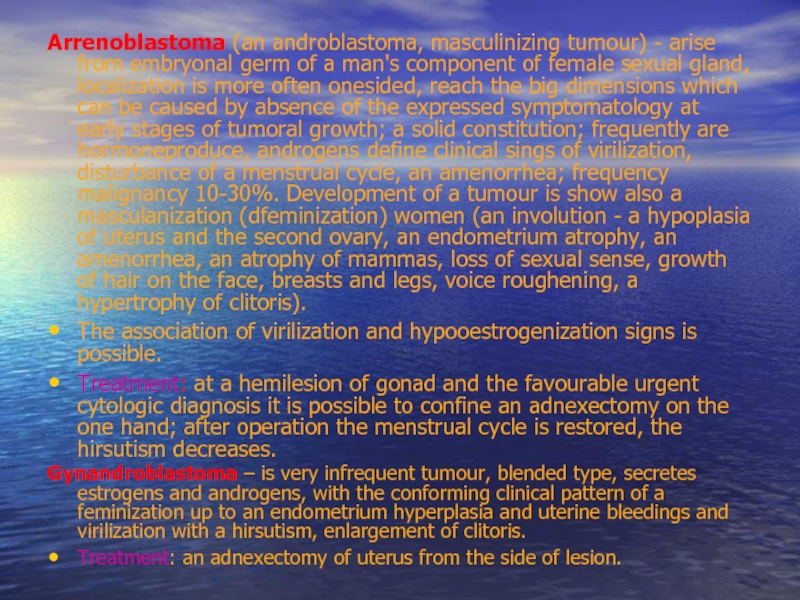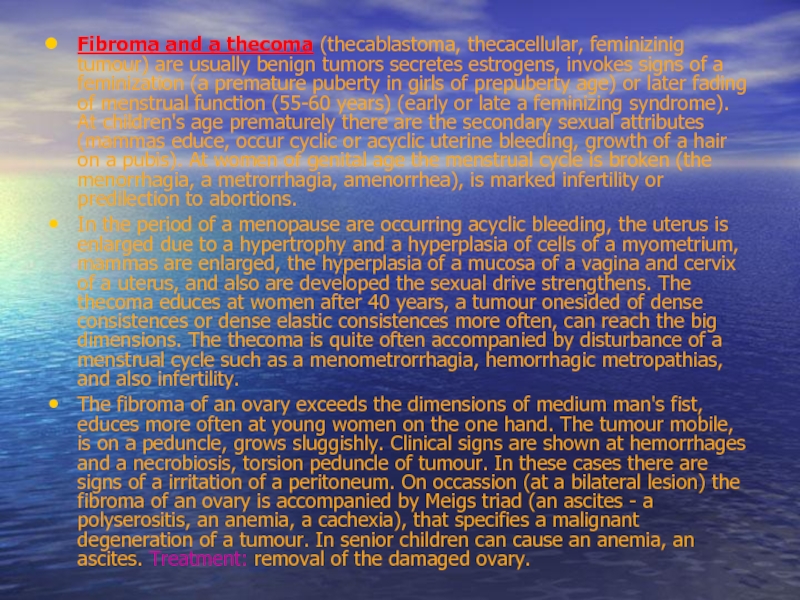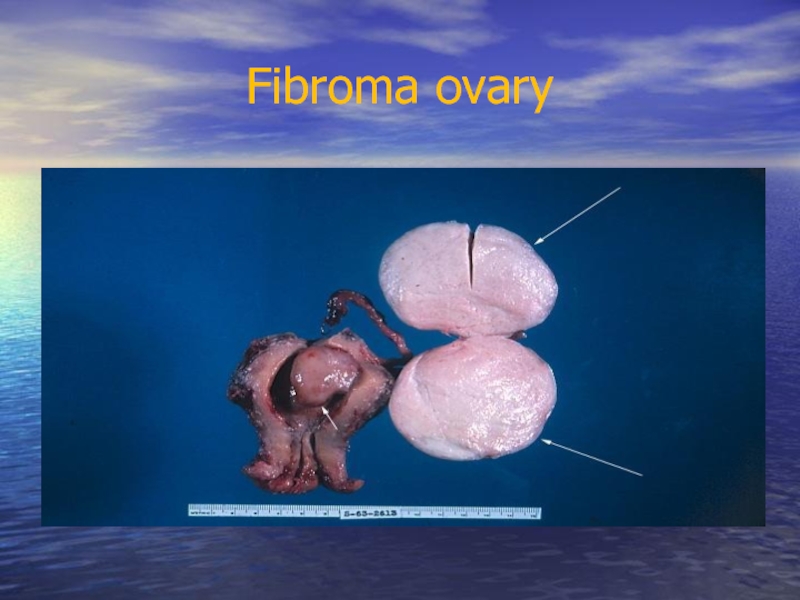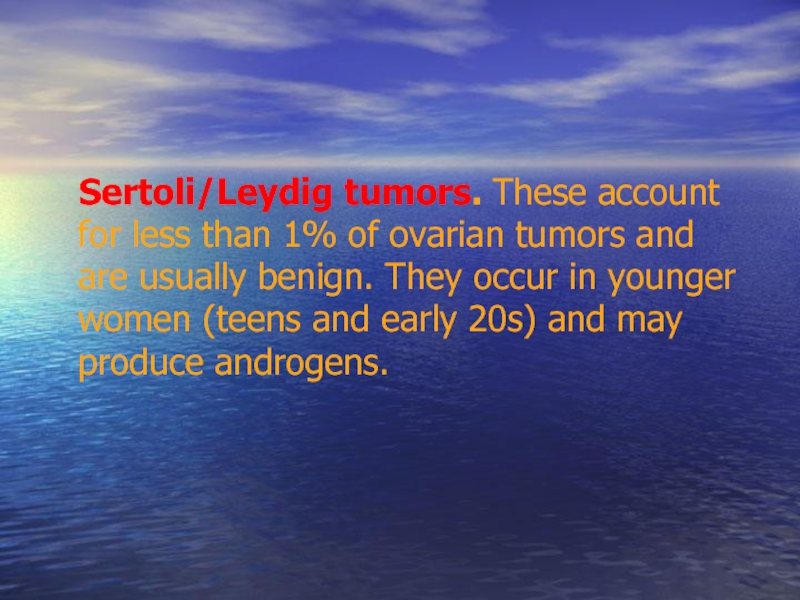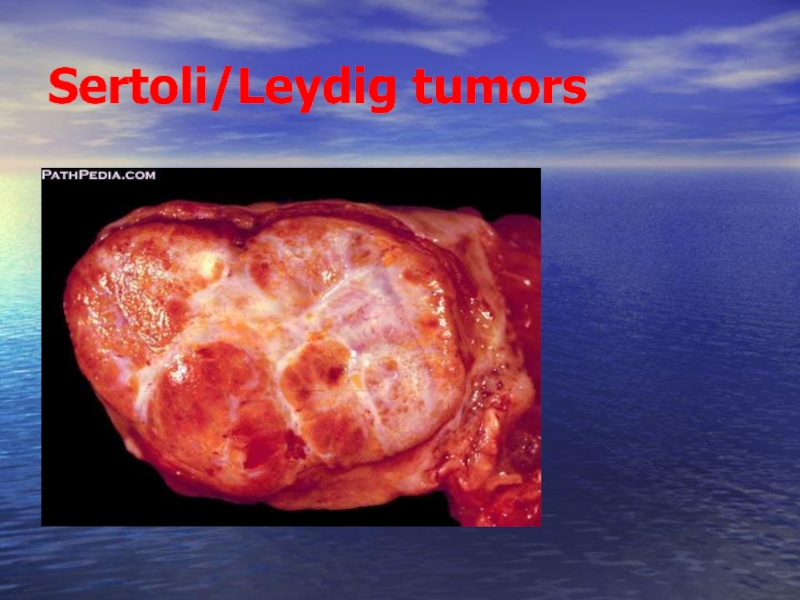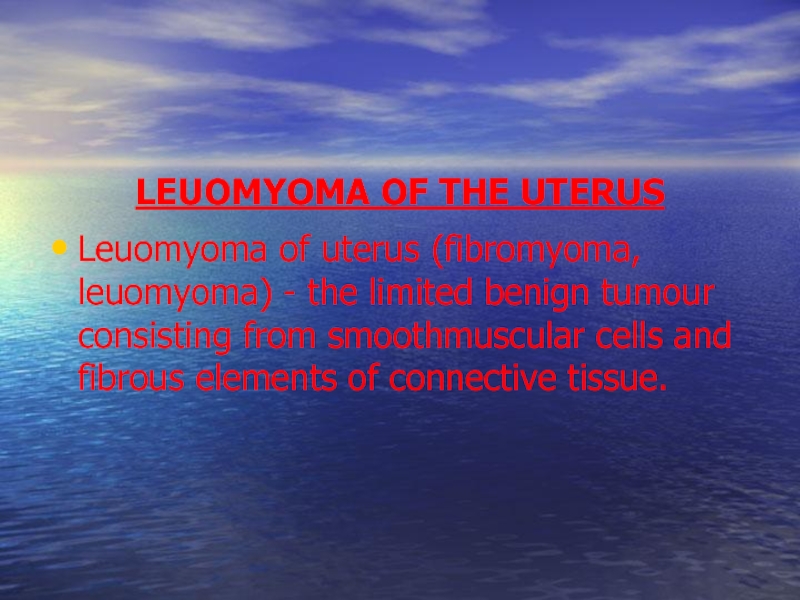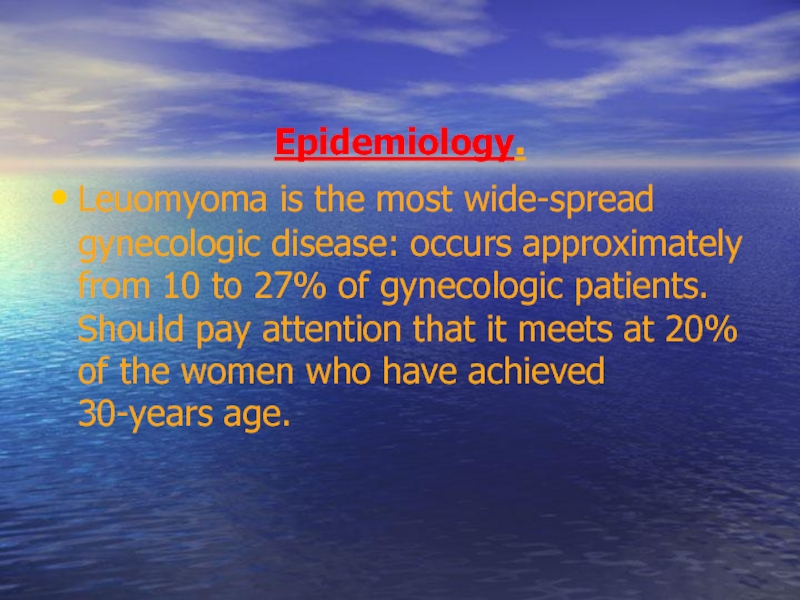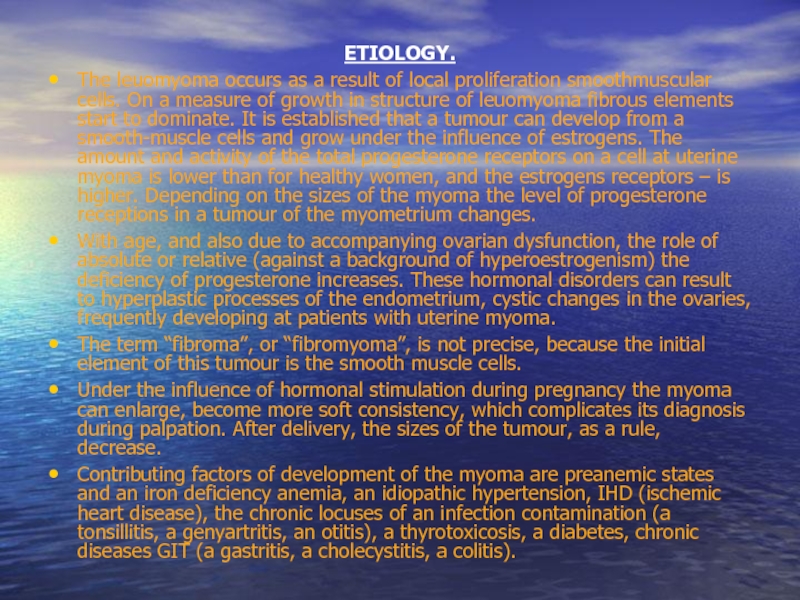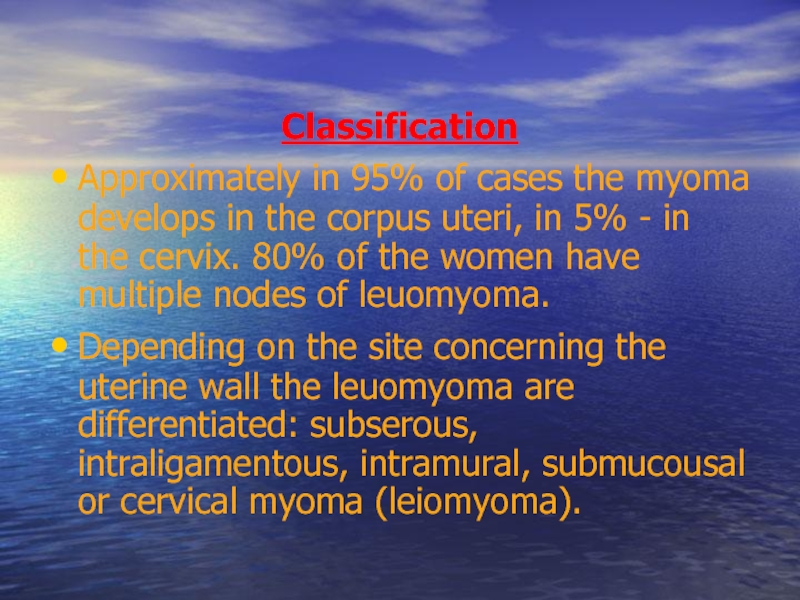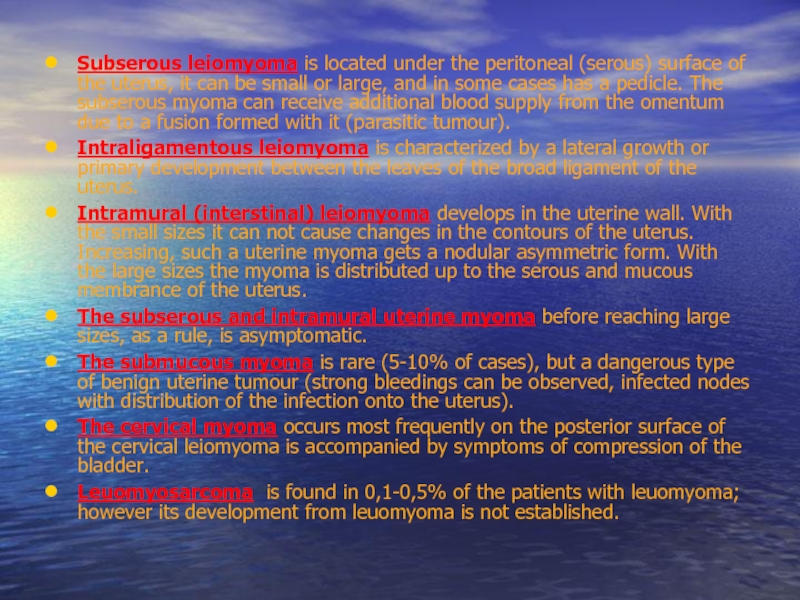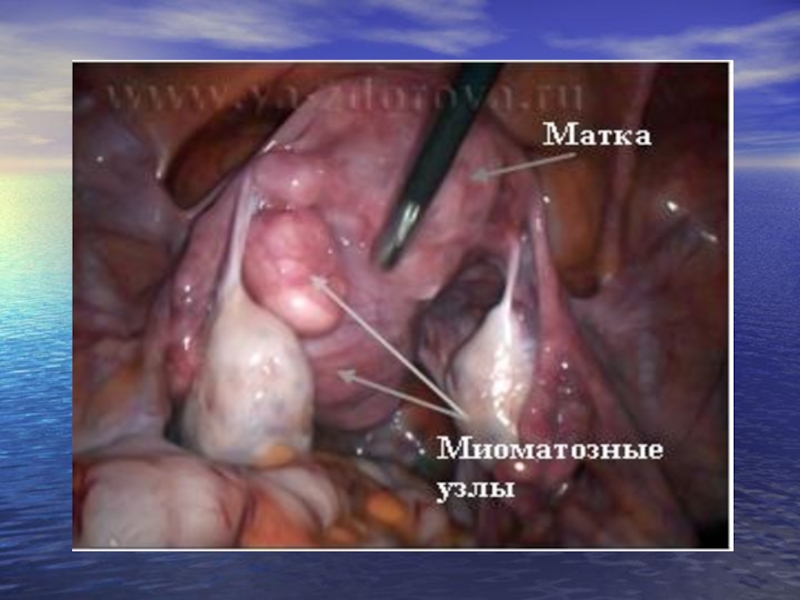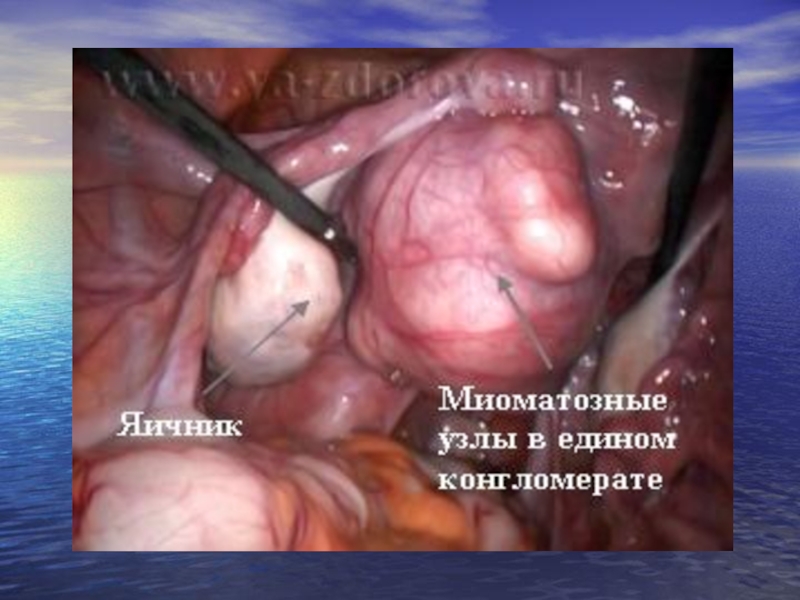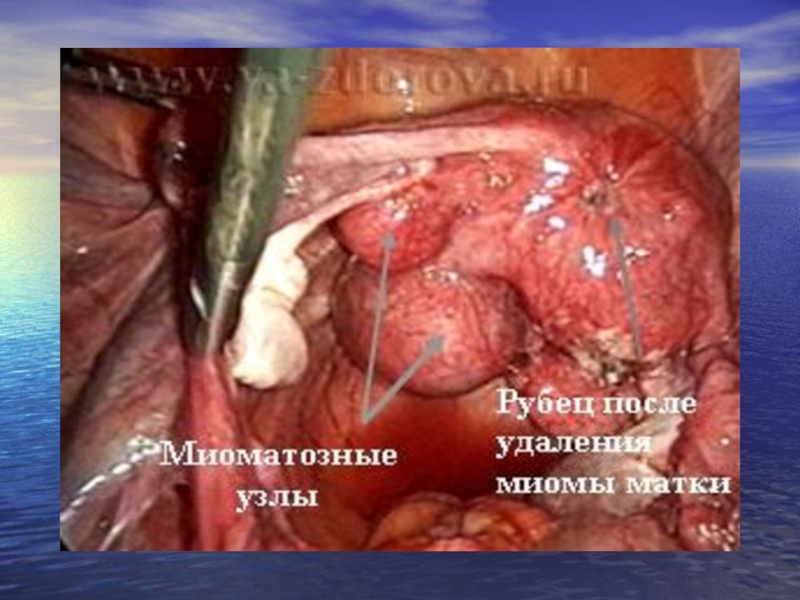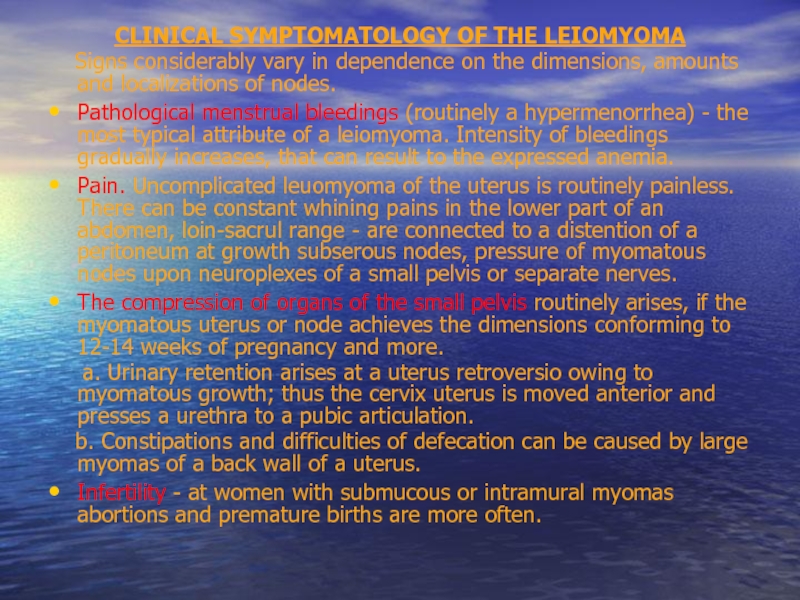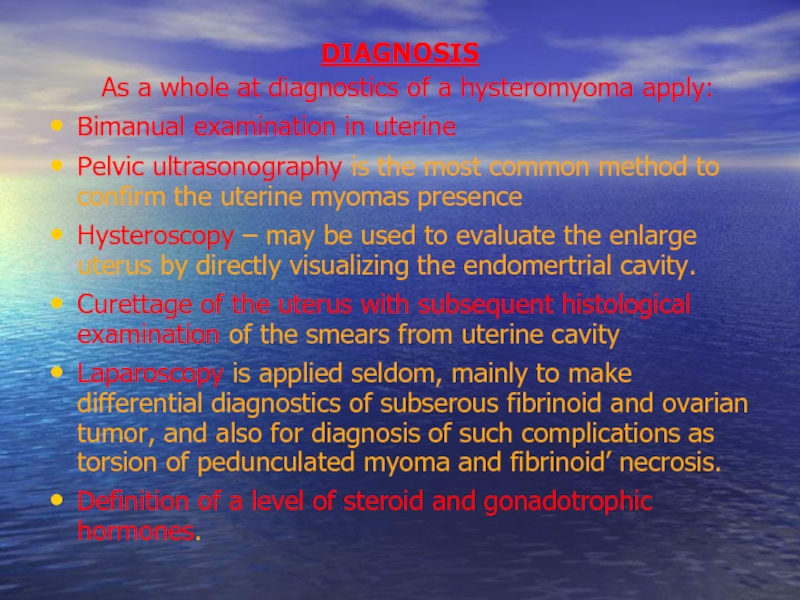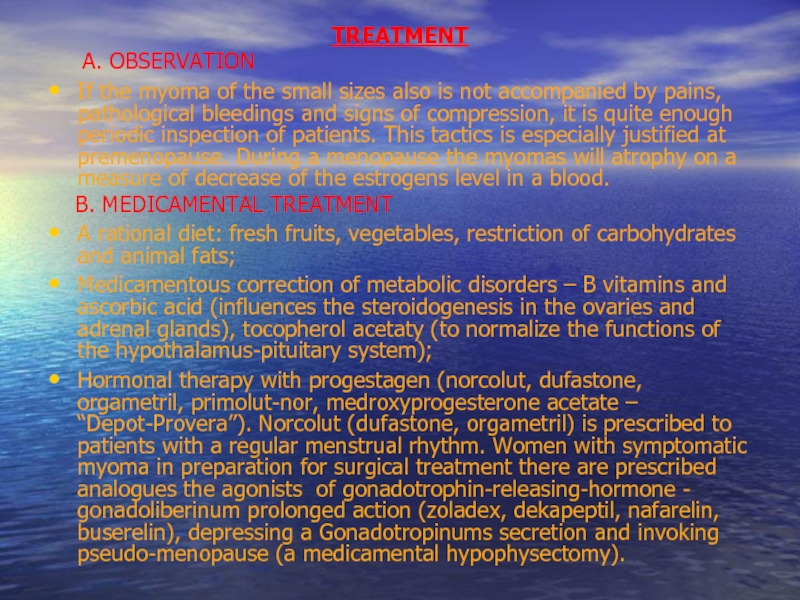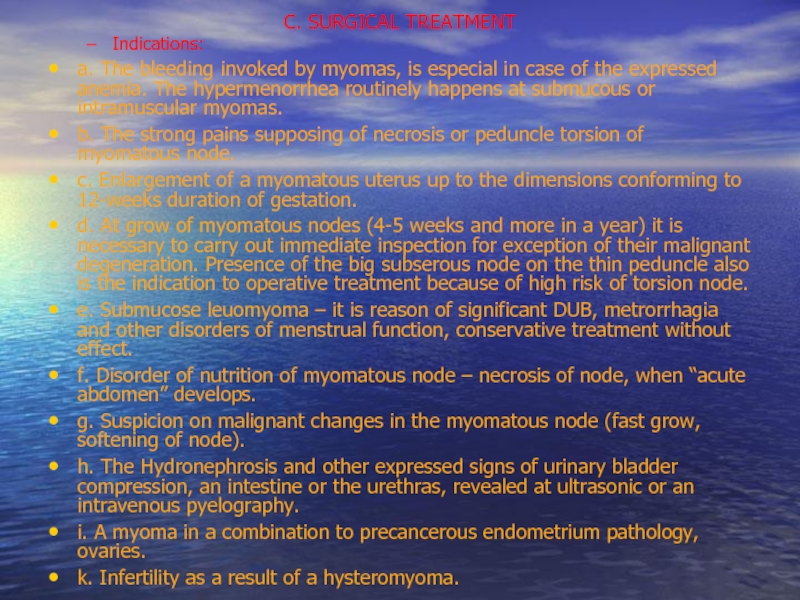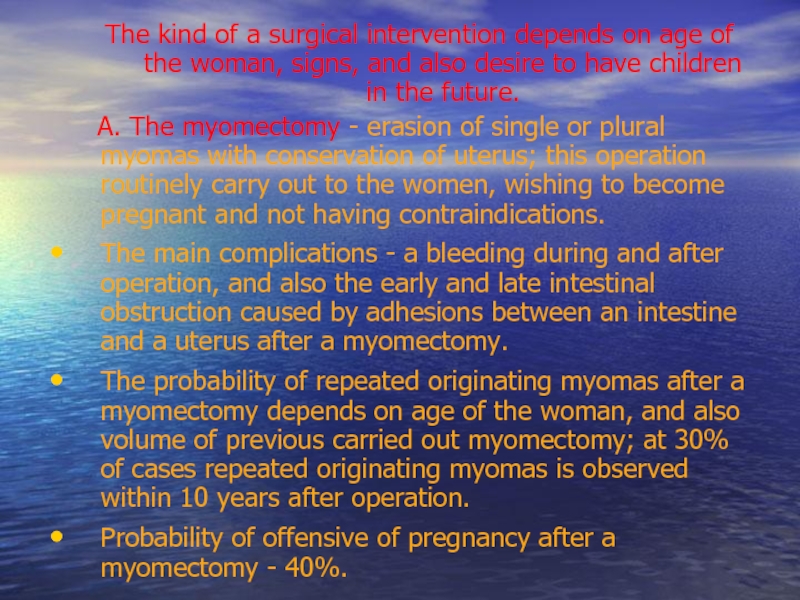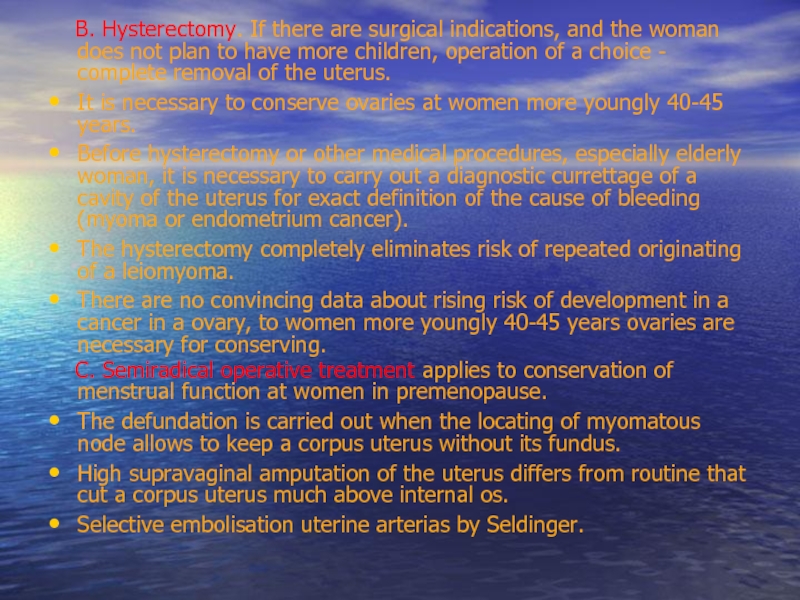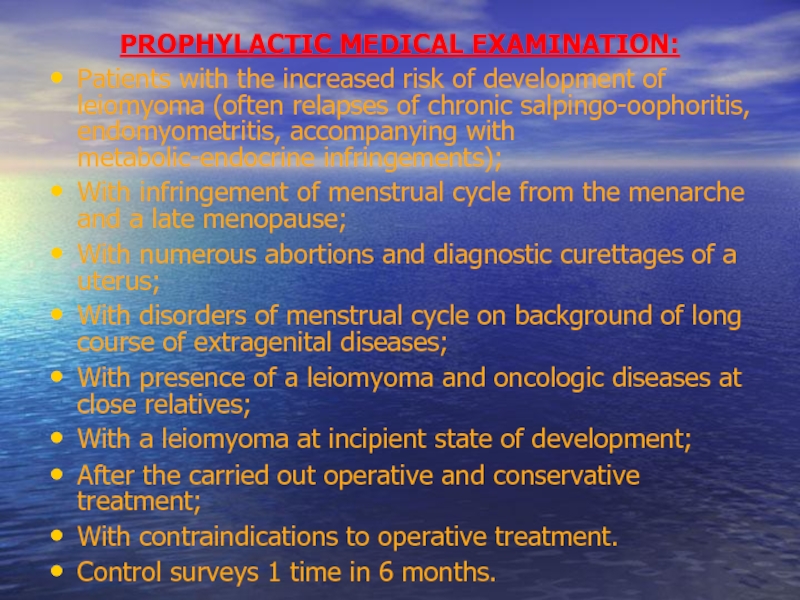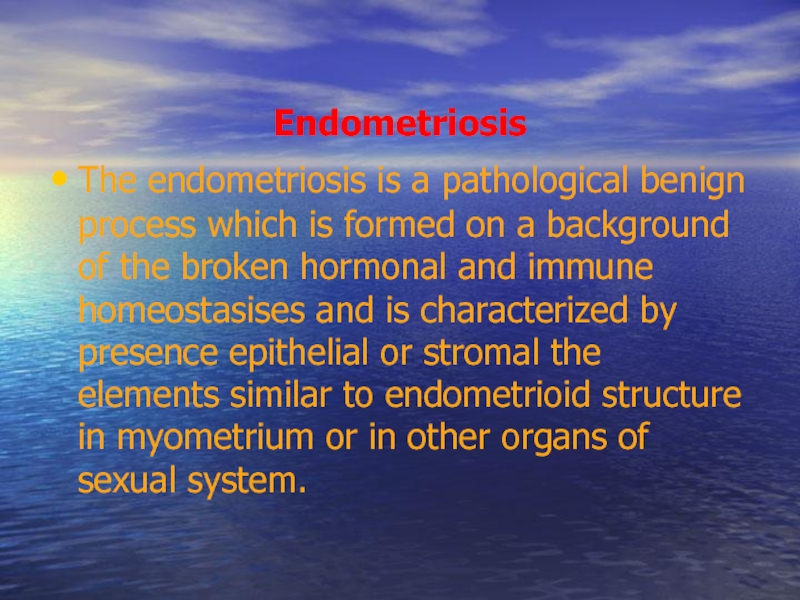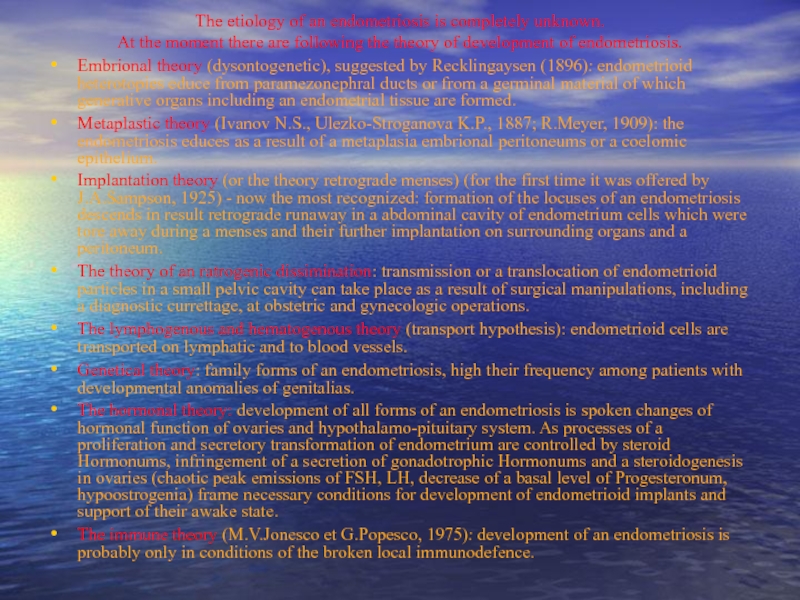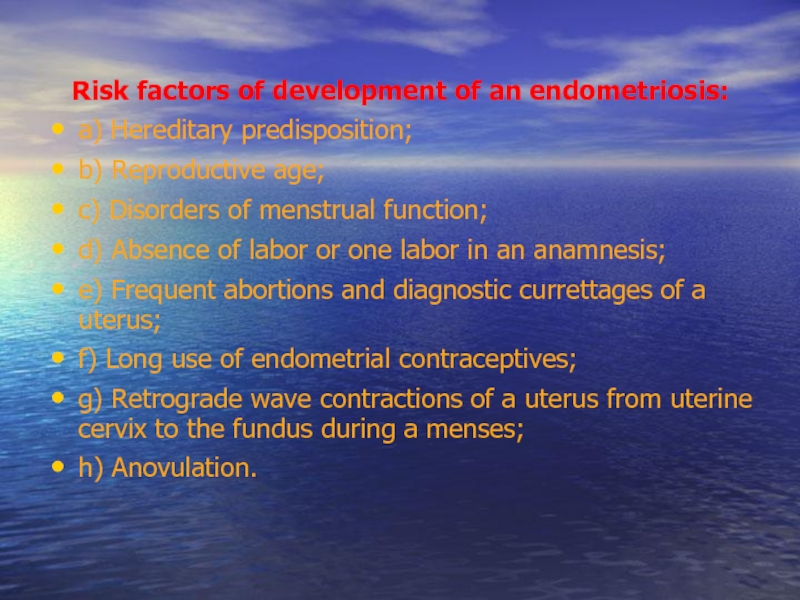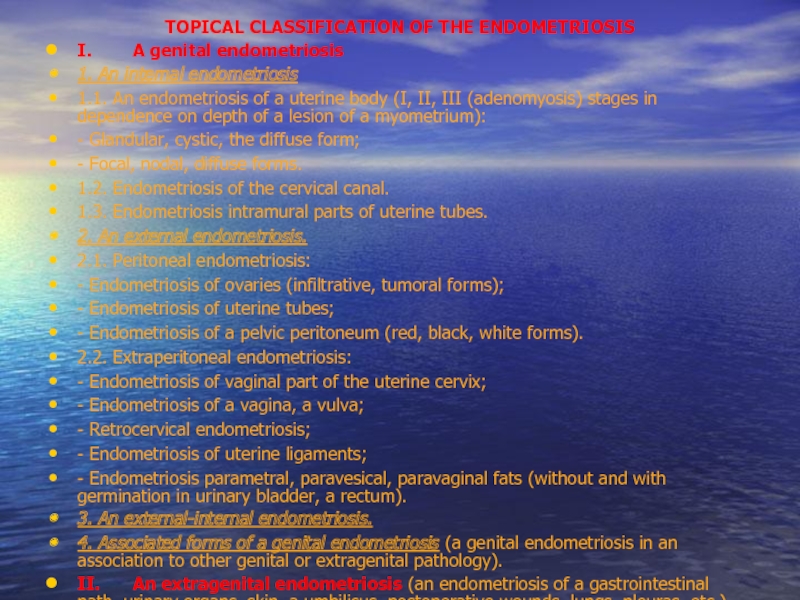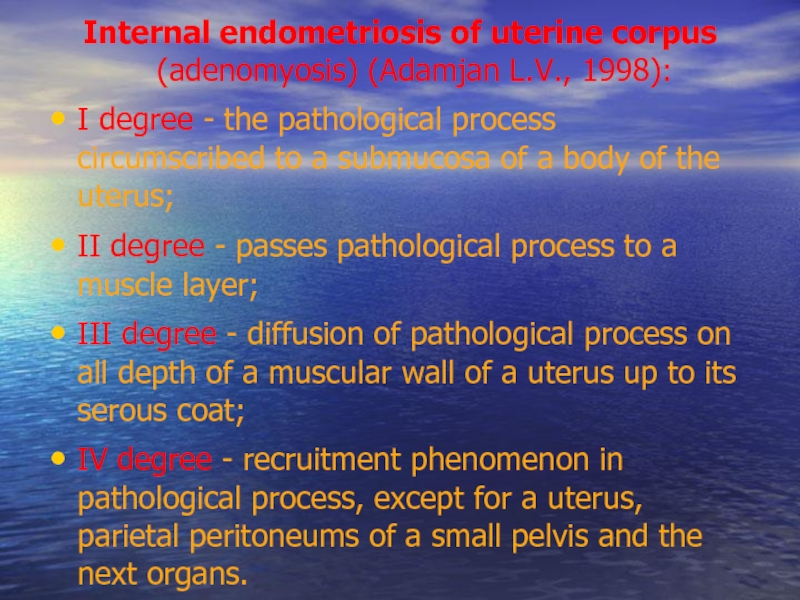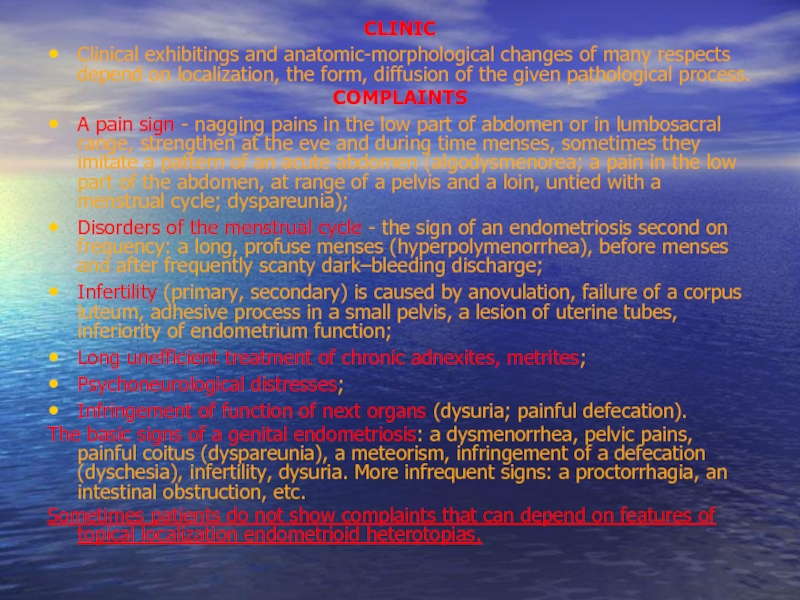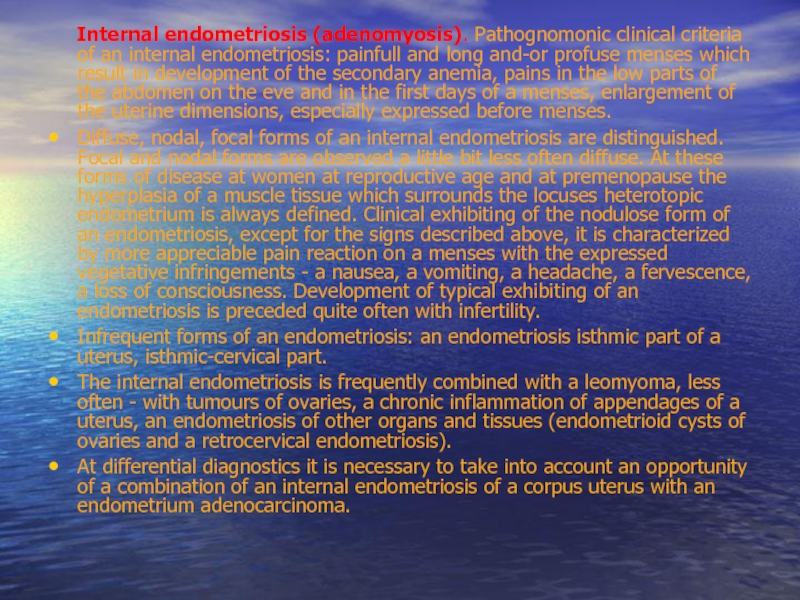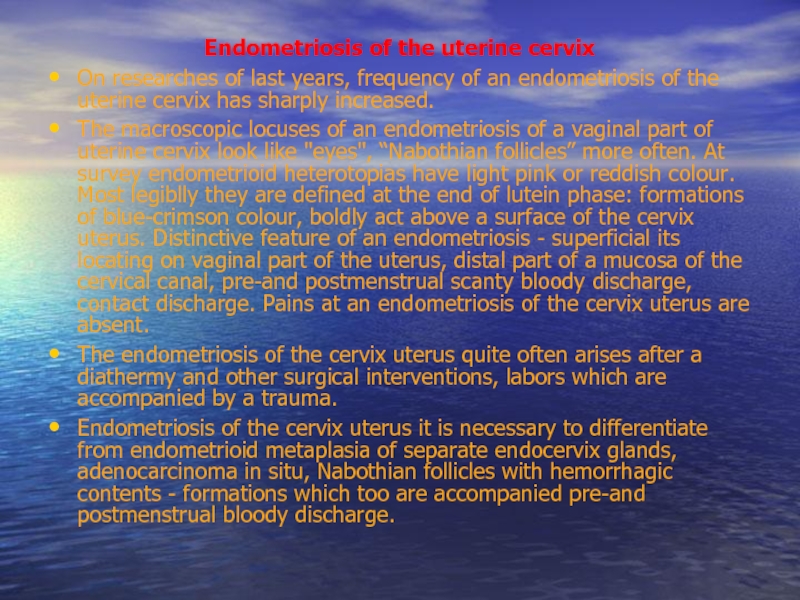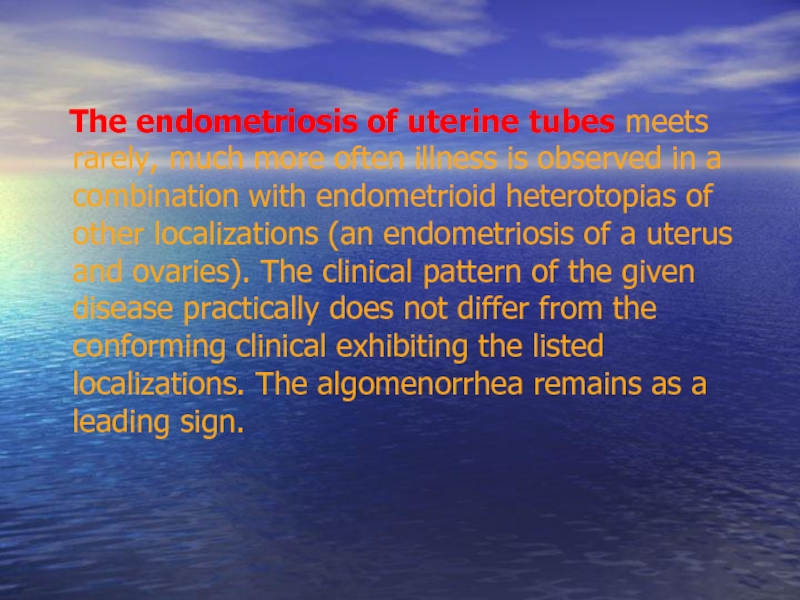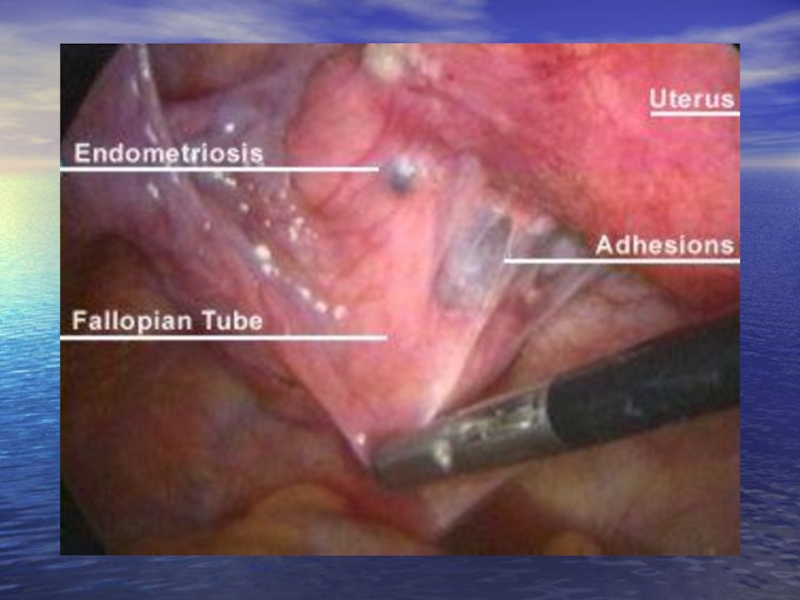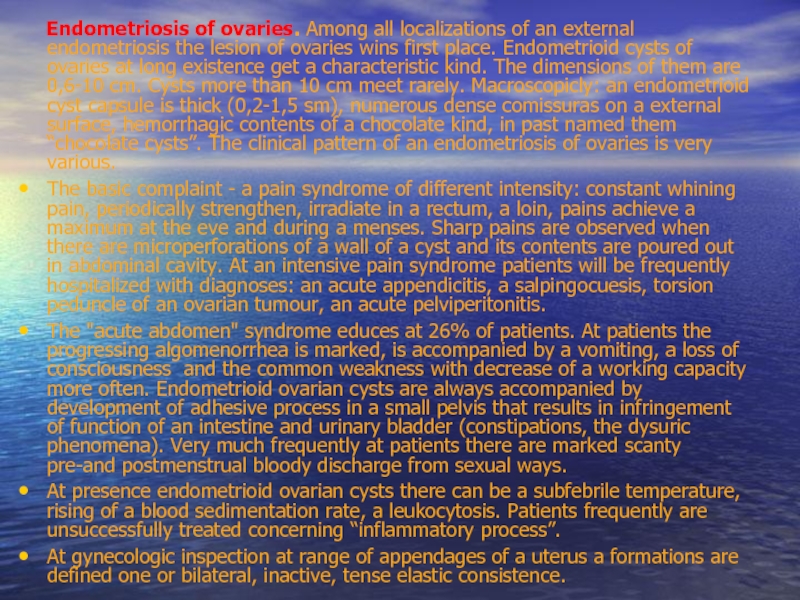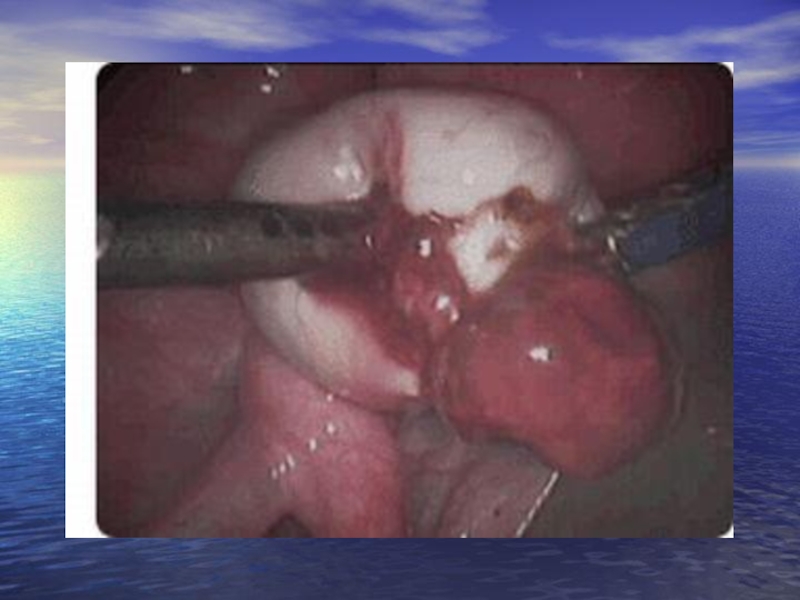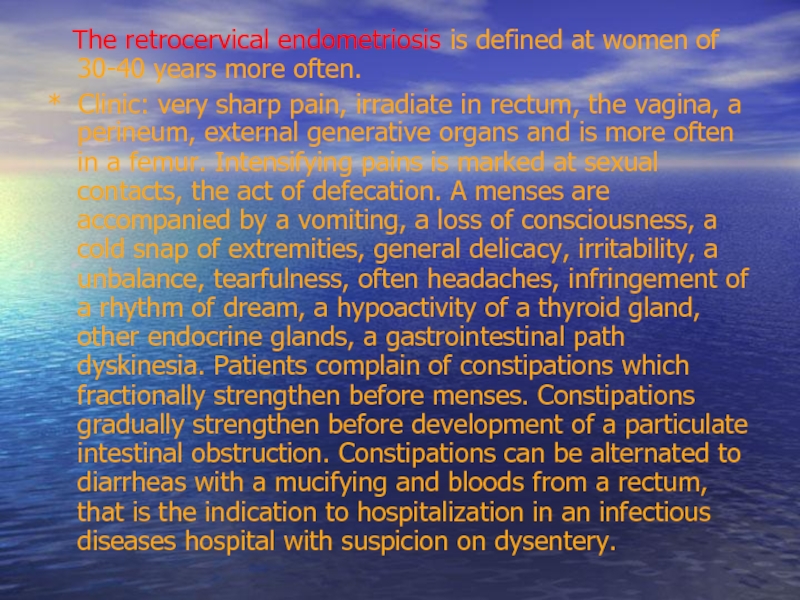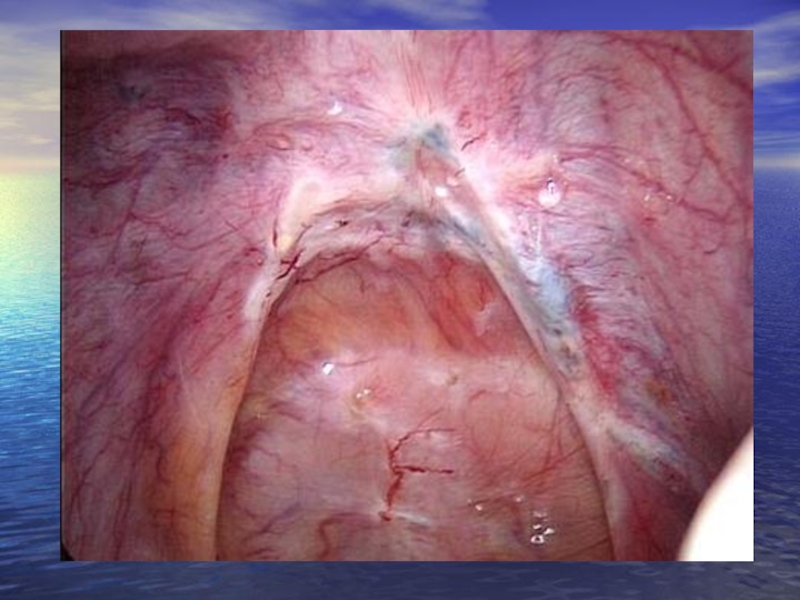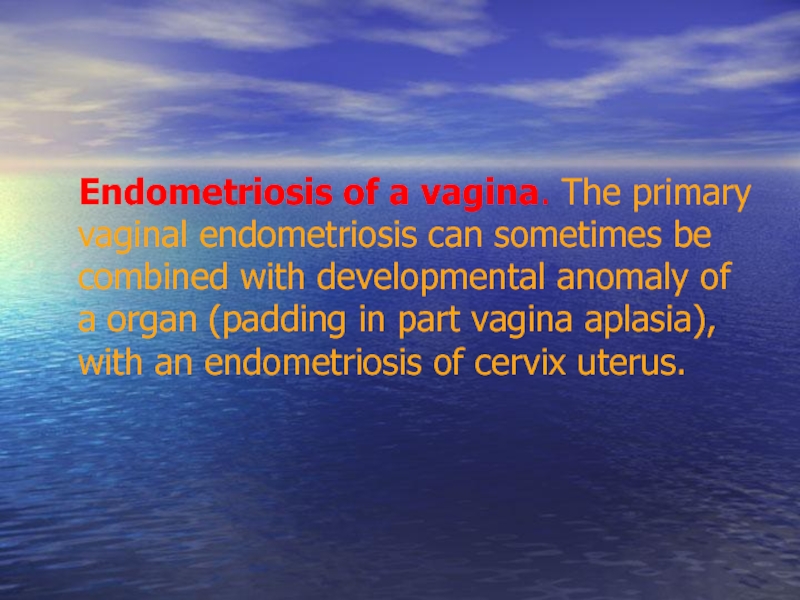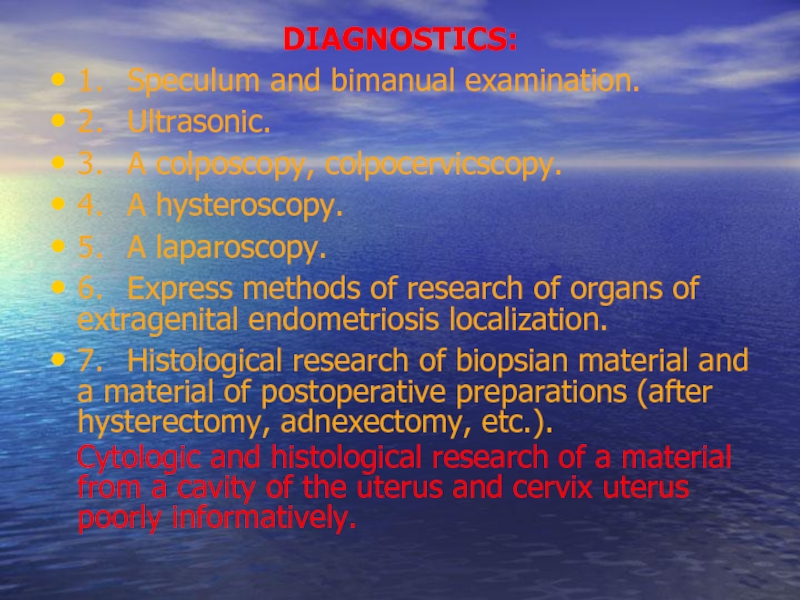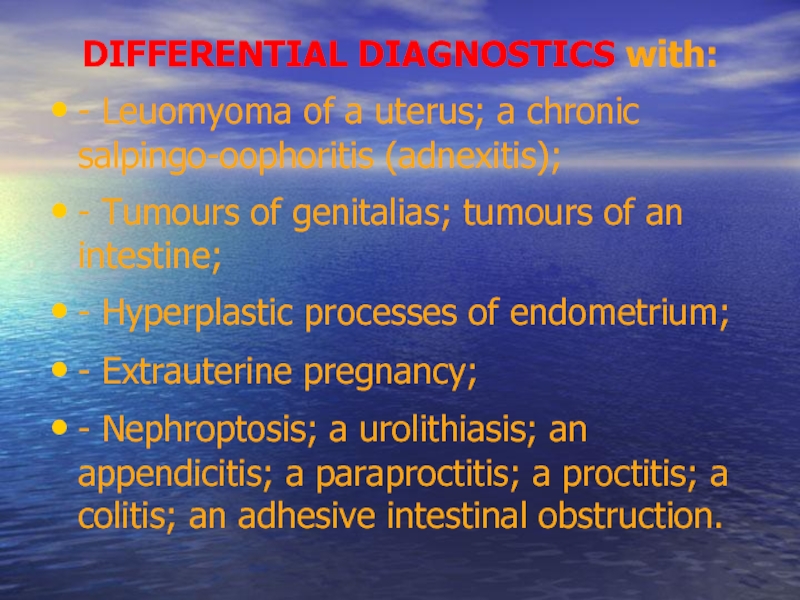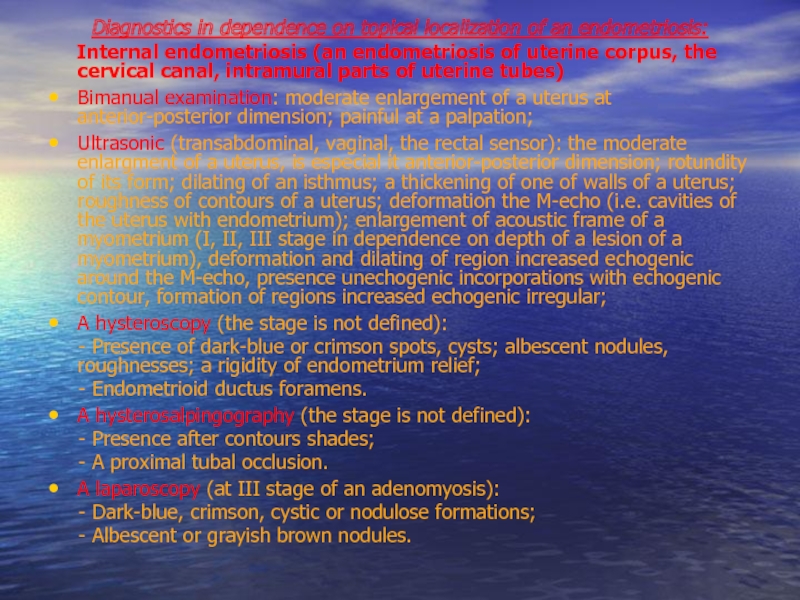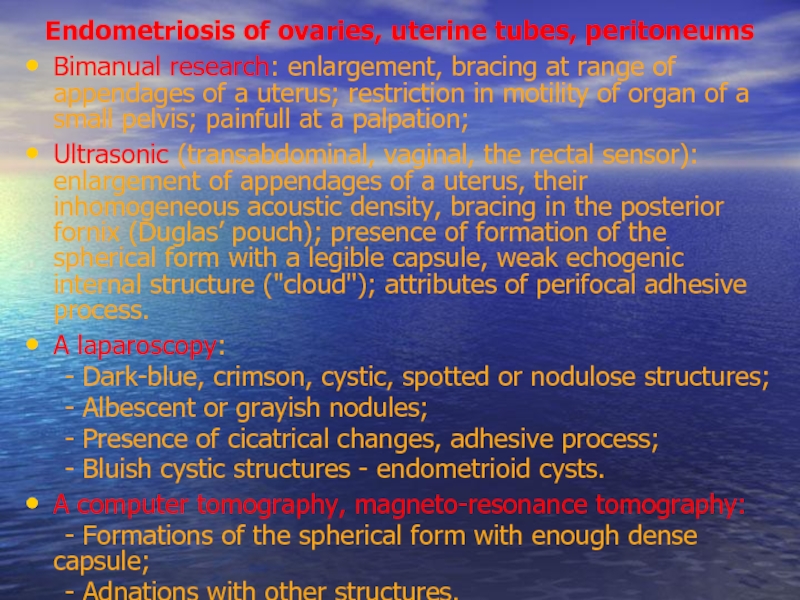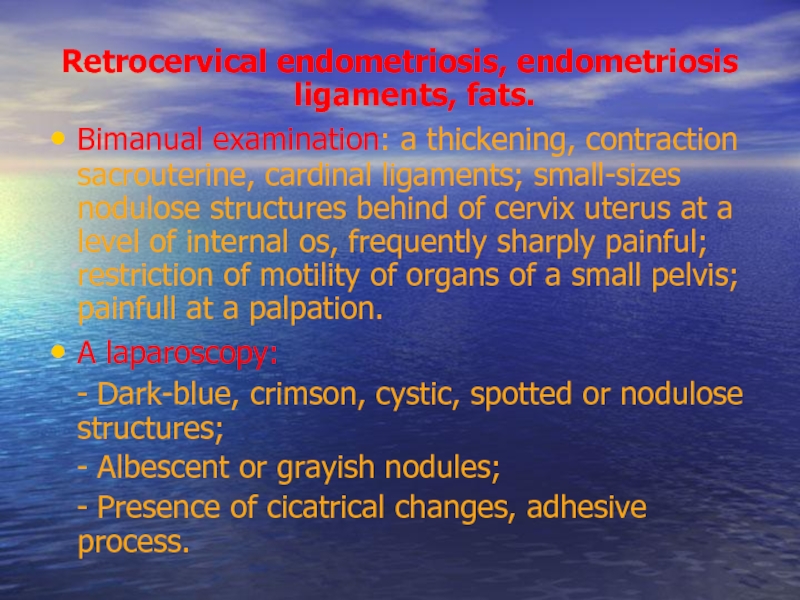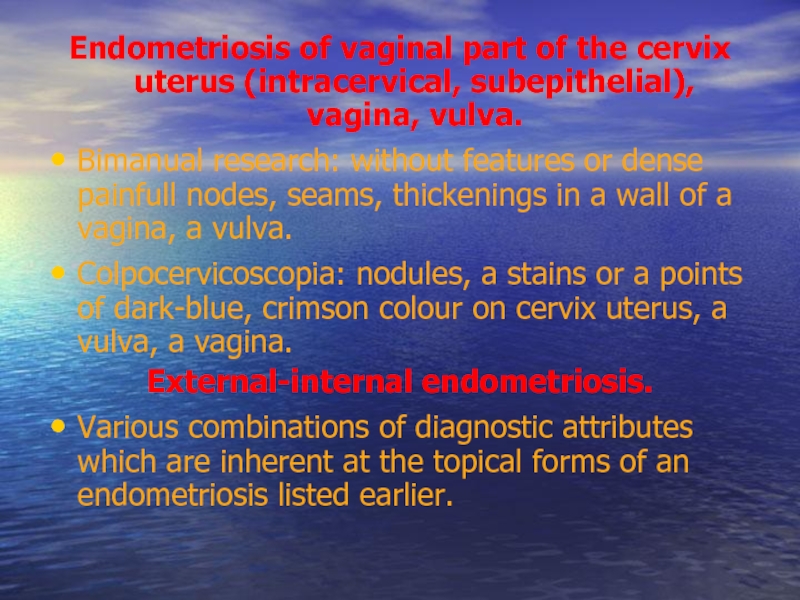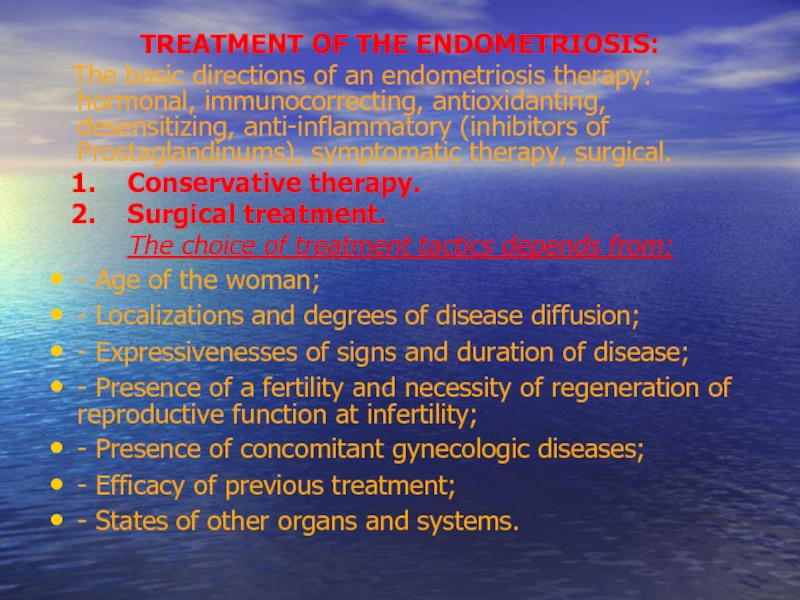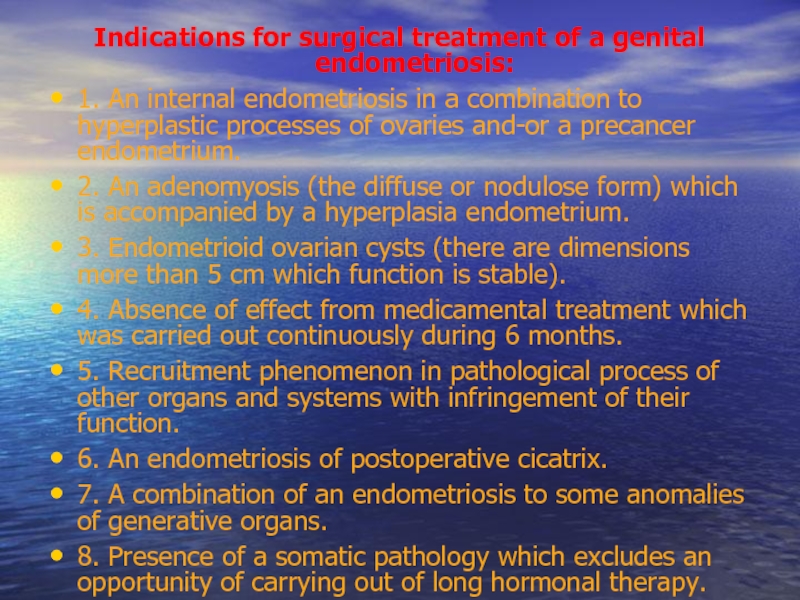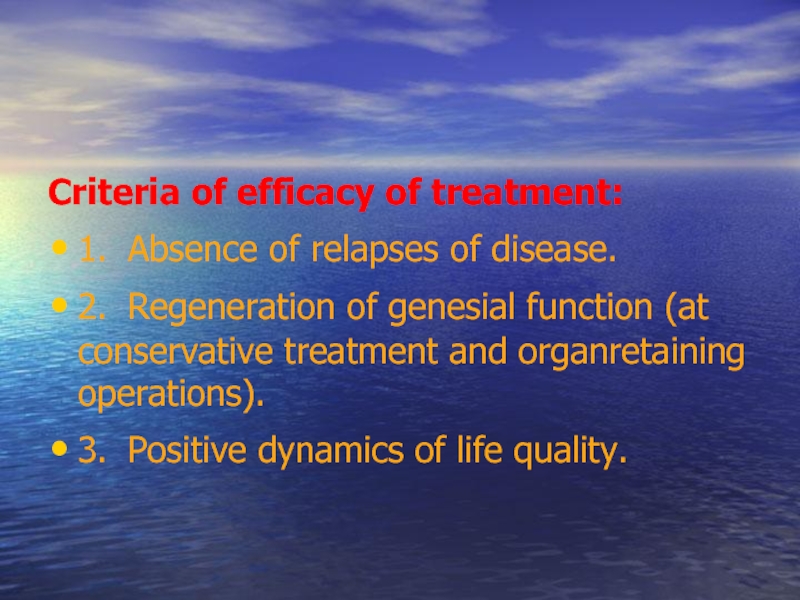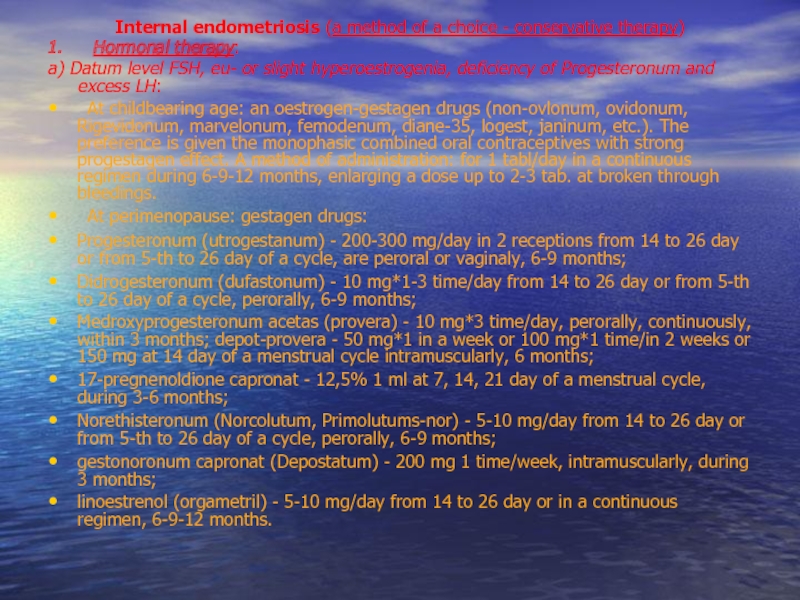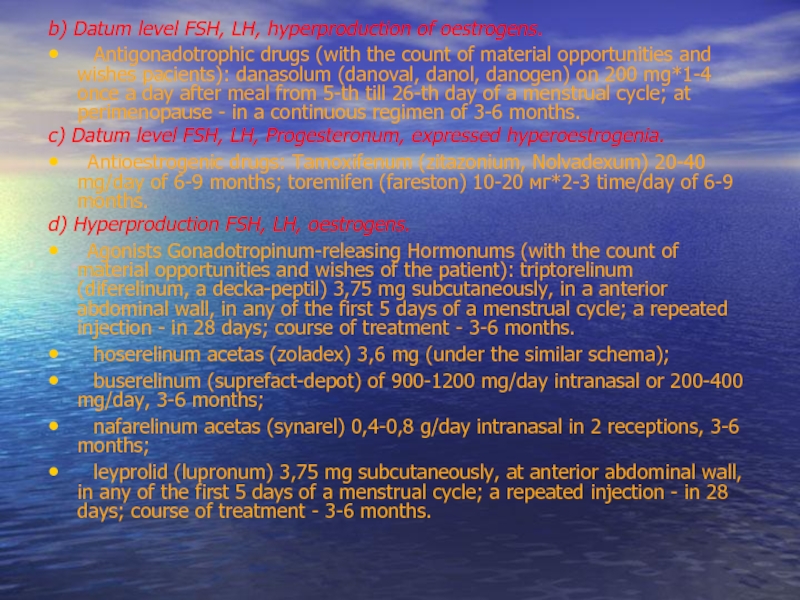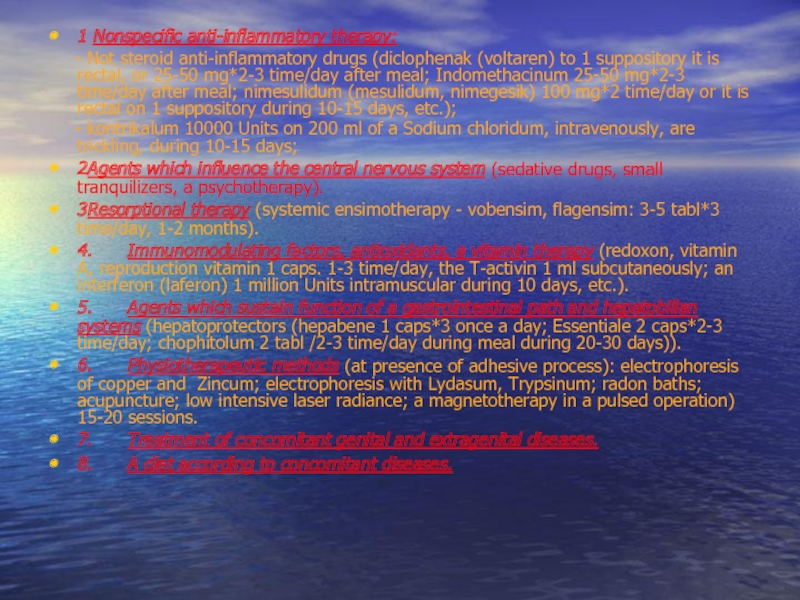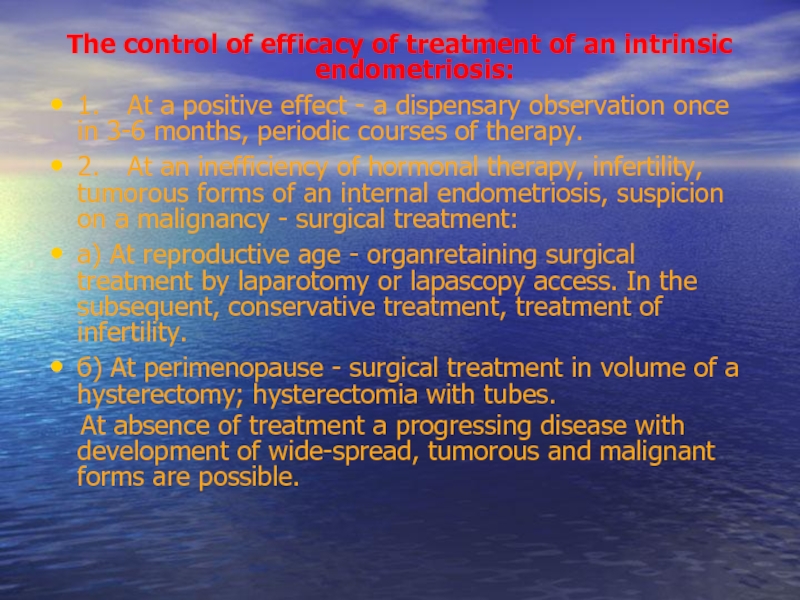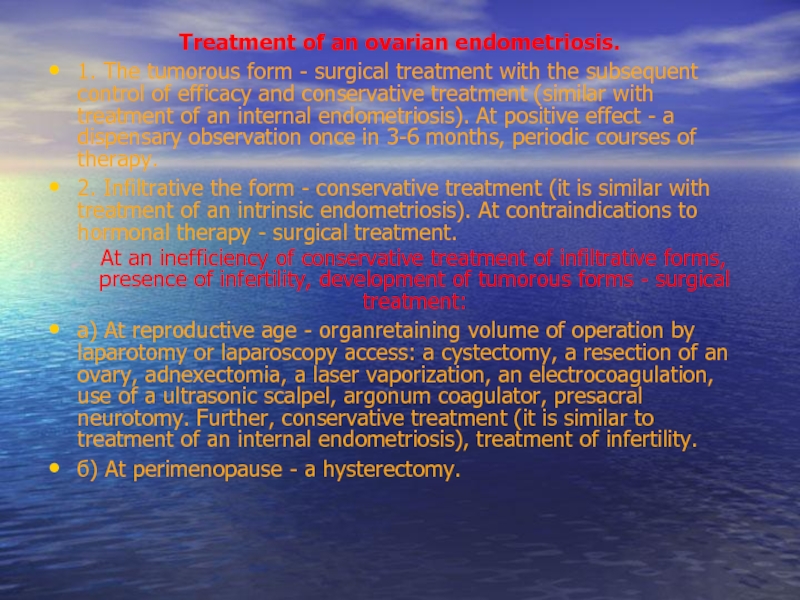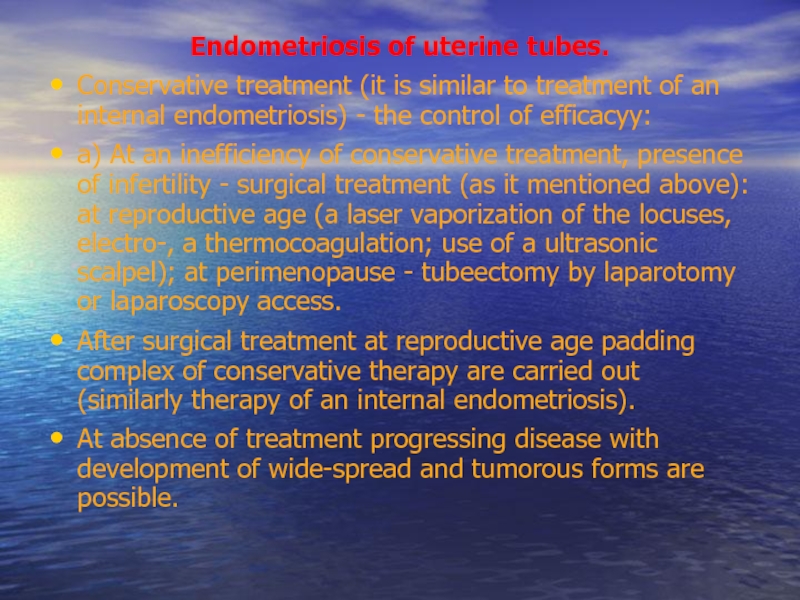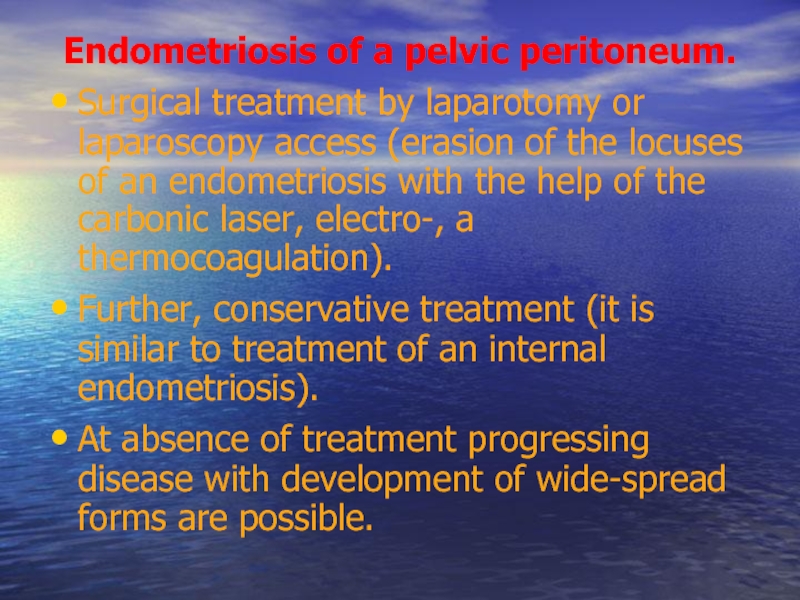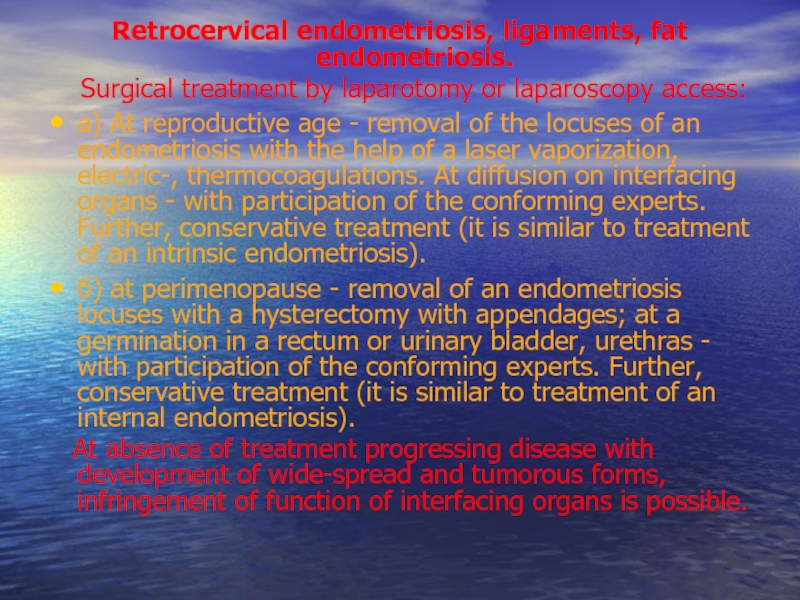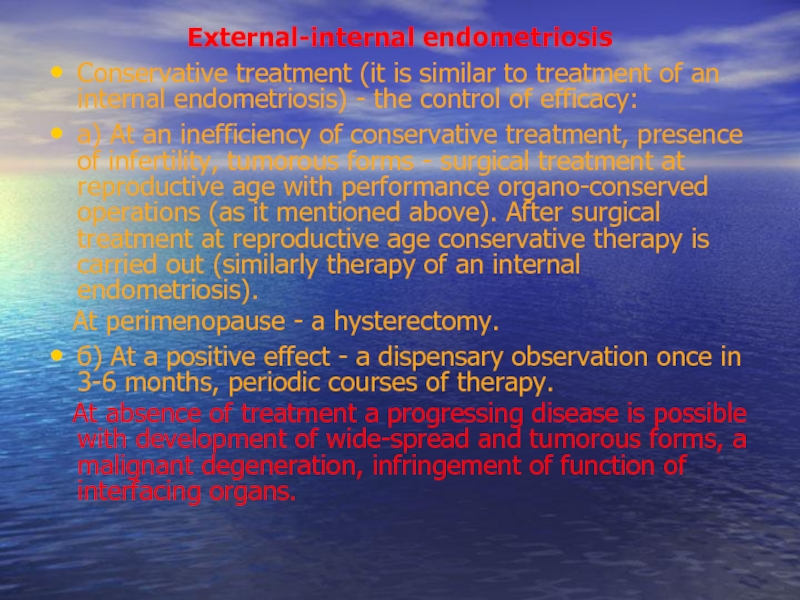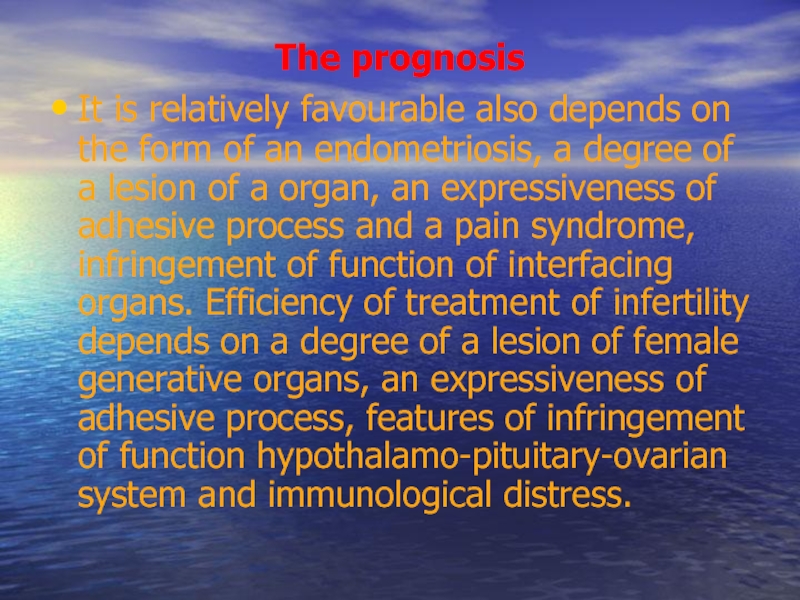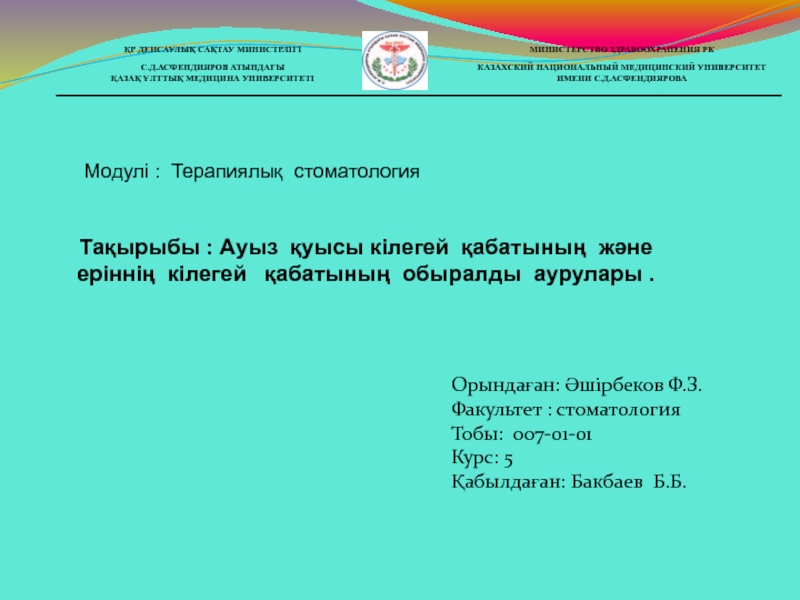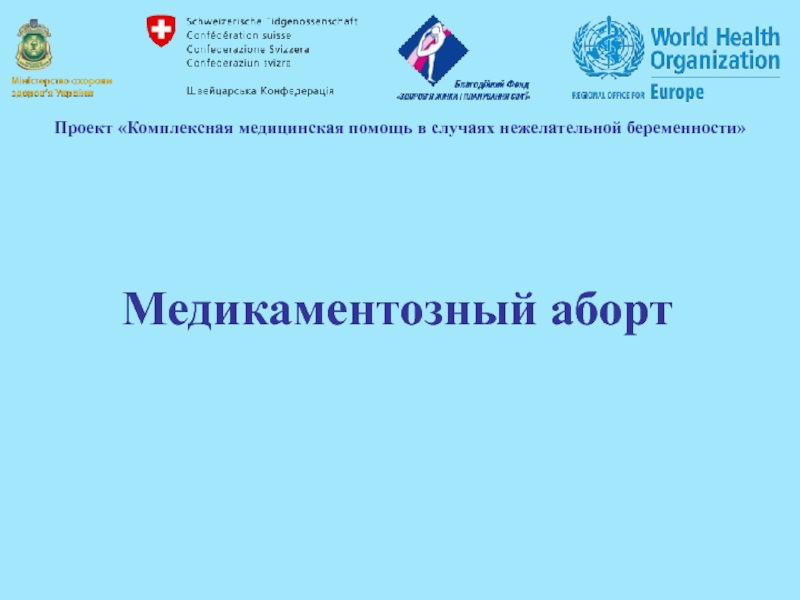- Главная
- Разное
- Дизайн
- Бизнес и предпринимательство
- Аналитика
- Образование
- Развлечения
- Красота и здоровье
- Финансы
- Государство
- Путешествия
- Спорт
- Недвижимость
- Армия
- Графика
- Культурология
- Еда и кулинария
- Лингвистика
- Английский язык
- Астрономия
- Алгебра
- Биология
- География
- Детские презентации
- Информатика
- История
- Литература
- Маркетинг
- Математика
- Медицина
- Менеджмент
- Музыка
- МХК
- Немецкий язык
- ОБЖ
- Обществознание
- Окружающий мир
- Педагогика
- Русский язык
- Технология
- Физика
- Философия
- Химия
- Шаблоны, картинки для презентаций
- Экология
- Экономика
- Юриспруденция
Benign tumors of the female genital organs презентация
Содержание
- 1. Benign tumors of the female genital organs
- 3. Benign ovarian cysts are commonly encountered problem
- 4. 90% of ovarian tumors are benign,
- 5. The main objective in the management of
- 6. Ovarian tumors are physiological or pathological and
- 7. Tumours of ovaries are divided
- 8. Functional cysts * Follicular cyst * Corpus
- 9. Follicular and Corpus Luteal cysts (lutein cysts)
- 11. Germinogenic benign ovarian tumors
- 12. Mature teratomas account for a quarter of
- 14. Ummature teratomas (teratoblastoma) – can occur but
- 15. Serous cystadenomas are the most
- 17. Mucinous tumours (mucinous cystadenoma). Mucinous tumors can
- 19. Pseudomyxoma - rarely meeting tumour of an
- 21. Endometriotic cysts are sometimes called
- 24. Brenner’s tumour - it is epithelial–connective tissue.
- 25. The right ovary is replaced by a
- 26. Granulosa cell tumors (folliculoma). These account for
- 28. Arrenoblastoma (an androblastoma, masculinizing tumour) - arise
- 29. Fibroma and a thecoma (thecablastoma, thecacellular, feminizinig
- 30. Fibroma ovary
- 31. Sertoli/Leydig tumors. These account for
- 32. Sertoli/Leydig tumors
- 33. LEUOMYOMA OF THE UTERUS Leuomyoma of uterus
- 34. Epidemiology. Leuomyoma is the most wide-spread gynecologic
- 35. ETIOLOGY. The leuomyoma occurs as a result
- 36. Classification Approximately in 95% of cases the
- 37. Subserous leiomyoma is located under the peritoneal
- 41. CLINICAL SYMPTOMATOLOGY OF THE LEIOMYOMA
- 42. DIAGNOSIS As a whole at diagnostics
- 43. TREATMENT А. OBSERVATION If
- 44. C. SURGICAL TREATMENT Indications: а. The bleeding
- 45. The kind of a surgical intervention depends
- 46. B. Hysterectomy. If there are
- 47. PROPHYLACTIC MEDICAL EXAMINATION: Patients with the increased
- 48. Endometriosis The endometriosis is a pathological benign
- 49. The etiology of an endometriosis is completely
- 50. Risk factors of development of an endometriosis:
- 51. TOPICAL CLASSIFICATION OF THE ENDOMETRIOSIS I.
- 52. Internal endometriosis of uterine corpus (adenomyosis) (Adamjan
- 53. CLINIC Clinical exhibitings and anatomic-morphological changes of
- 54. Internal endometriosis (adenomyosis). Pathognomonic
- 55. Endometriosis of the uterine cervix On researches
- 56. The endometriosis of uterine tubes
- 58. Endometriosis of ovaries. Among
- 60. The retrocervical endometriosis is defined
- 62. Endometriosis of a vagina. The
- 63. DIAGNOSTICS: 1. Speculum and bimanual examination. 2. Ultrasonic. 3. A
- 64. DIFFERENTIAL DIAGNOSTICS with: - Leuomyoma of a
- 65. Diagnostics in dependence on topical localization of
- 66. Endometriosis of ovaries, uterine tubes, peritoneums Bimanual
- 67. Retrocervical endometriosis, endometriosis ligaments, fats. Bimanual examination:
- 68. Endometriosis of vaginal part of the cervix
- 69. TREATMENT OF THE ENDOMETRIOSIS: The
- 70. Indications for surgical treatment of a genital
- 71. Criteria of efficacy of treatment: 1. Absence of
- 72. Internal endometriosis (a method of a choice
- 73. b) Datum level FSH, LH, hyperproduction of
- 74. 1 Nonspecific anti-inflammatory therapy:
- 75. The control of efficacy of treatment of
- 76. Treatment of an ovarian endometriosis. 1. The
- 77. Endometriosis of uterine tubes. Conservative treatment (it
- 78. Endometriosis of a pelvic peritoneum. Surgical treatment
- 79. Endometriosis vaginal part of an uterine cervix,
- 80. Retrocervical endometriosis, ligaments, fat endometriosis.
- 81. External-internal endometriosis Conservative treatment (it is similar
- 82. The prognosis It is relatively favourable also
Слайд 3Benign ovarian cysts are commonly encountered problem in gynecological practice and
Слайд 4 90% of ovarian tumors are benign, although this index varies
Слайд 5The main objective in the management of patients with benign ovarian
Слайд 6Ovarian tumors are physiological or pathological and formed with any tissue,
The management of each of ovarian tumors is different. However, only when a specimen is analysed in the pathology laboratory can we know for sure what the diagnosis is. A clinician has to utilise his clinical acumen and the results of investigations to help determine management and make a clinical diagnosis.
Слайд 7 Tumours of ovaries are divided
into two basic groups:
blastomatous
non blastomatous (not proliferating) tumours of an ovary, or a cyst.
Blastomatous tumours (cystoma) are the true tumours having unlimited growth.
Not blastomatous tumours (cysts) have limited growth and reach small size.
Слайд 8Functional cysts
* Follicular cyst
* Corpus Luteal cyst
Germinogenic benign ovarian tumors
* Mature
* Immature teratomas
Epithelial ovarian tumors
* Serous cystadenoma
* Mucinous cystadenoma
* Endometrioid cystadenoma
* Brener’s tumor
* Clear Cell tumor
Benign sex cord / stromal ovarian tumors
* Granulosa tumors
* Theca cell tumors
* Fibroma
* Sertoli/Leydig tumors
The classification of benign ovarian tumors
(for the histological conclusion)
Слайд 9Follicular and Corpus Luteal cysts (lutein cysts) occur in reproductive life
follicular cysts - tumorous formations which educe on a background of inflammatory process owing to accumulation of fluid in a cyst-atretic follicle, or can be caused by infringement of hypothalamic-hypophysial regulation of function of ovaries; cavitary, thin-walled unicameral formation, unilateral, 2-7 cm in diameter; sometimes hormonactivity as contain estrogens.
lutein cysts - are surveyed as anatomical variant of normal constitution of corpus luteum; can be consequence of inflammatory diseases of ovaries or hyperproduction of gonadotrophic Hormones by adenohypophysis; at girls appearance of cyst is connected to hypersecretion of Prolactinum, arise in the period of sexual maturity, is more often at biphase menstrual cycle.
The management is usually by observation alone. These cysts can also be treated by suppressing ovarian activity with the contraceptive pill. Sometimes for failure of conservative therapy it is necessary perform an ovarian cystectomy.
Слайд 11
Germinogenic benign ovarian tumors can be benign mature teratoma
Слайд 12Mature teratomas account for a quarter of all benign ovarian cysts
Struma of an ovary - a tumour which on histological structure is very similar to a thyroid gland. This tumour concerns to a mature teratoma. It is routinely onesided, grows quickly, but preserves benign character. Occurs early as the increasing phenomena of thyrotoxicosis combined to presence of tumour of ovary (a fast-growing, dense consistence, with pulled surface, concerning the small dimensions, on a peduncle). Treatment is surgical - removal of cystoma together with an ovary.
Слайд 14Ummature teratomas (teratoblastoma) – can occur but are rare. They are
Слайд 15 Serous cystadenomas are the most common epithelial tumors and
The simple serous cystoma - is more often unicameral formation with serous contents. A capsule wall is smooth. Treatment of cystoma is only surgical.
The papillary cystoma (proliferating) more often bilateral, multichamber, has a tachyauxesis, is inclined to a malignant degeneration (up to 80% of cases).
On an internal surface of capsule an abundant papillary growths are formed. At malignant degeneration the growth pass on visceral peritoneum and a peritoneum of the next organs. The papillary cystoma of routinely small dimensions (its maximal size - about a neonatal head), is frequently accompanying by an ascites. Contents of a cyst is serous or serobloody.
Treatment is surgical, as well as at a simple serous cystoma.
Слайд 17Mucinous tumours (mucinous cystadenoma). Mucinous tumors can be borderline. Benign tumors
The pseudomucinous cystoma educes asymptomatically, the abdomen yet will not start to be enlarged. The tumour, even the big dimensions, sometimes is not accompanied by any clinical exhibiting. However at peduncle torsion or a necrosis of a capsule early there is a pain in the abdominal low or loin. Signs of compression of the next organs (urinary bladder, rectum, sacral neuroplex, lymphatic and venous vessels) occur late.
Treatment: at cystadenomas (serous and mucinous cystoma) removal of an ovary even is carried out when the ovary is submitted by a thin membrane around cystoma. At young age the tumour is removed together with an ovary. Bilateral removal of ovaries are after 48 years.
Слайд 19Pseudomyxoma - rarely meeting tumour of an ovary (type of pseudomucinous
Clinically the pseudomyxoma is accompanied by an abdominal distention, a pain at palpation of abdomen. Schotkin’s sign is weak positive in the inferior departments of an abdomen. At a breakage of a capsule of pseudomyxoma the signs of an acute irritation of a peritoneum can appear.
Treatment surgical. It is impossible to remove jelly-like masses from an abdominal cavity considerably. After operation it is necessary to administrate cytostatics.
Слайд 21 Endometriotic cysts are sometimes called chocolate cysts. They are
Слайд 24Brenner’s tumour - it is epithelial–connective tissue. It meets rarely, mainly
Clear Cell tumor. These are always malignant and carry a poor prognosis.
Слайд 25The right ovary is replaced by a Brenner tumor, the left
Слайд 26Granulosa cell tumors (folliculoma). These account for about 5% of ovarian
The tumour meets at any age, more often after 40 years. Asociation of feminizing syndrome, infringements of menstrual function, infertility with an ovary tumour (onesided) always specifies on hormoneproduce character of a tumour.
Treatment: removal of the damaged ovary, a biopsy of the second; at revealing low differentiated cells of tumour the volume of operation extends before removal of uterus with appendages and omenectomy with the further polychemotherapy. Be relative frequently a granulocellular tumour is combined with a fibromyoma and a hysterocarcinoma. There is a granulocellular tumour without the expressed hormonal activity.
Слайд 28Arrenoblastoma (an androblastoma, masculinizing tumour) - arise from embryonal germ of
The association of virilization and hypooestrogenization signs is possible.
Treatment: at a hemilesion of gonad and the favourable urgent cytologic diagnosis it is possible to confine an adnexectomy on the one hand; after operation the menstrual cycle is restored, the hirsutism decreases.
Gynandroblastoma – is very infrequent tumour, blended type, secretes estrogens and androgens, with the conforming clinical pattern of a feminization up to an endometrium hyperplasia and uterine bleedings and virilization with a hirsutism, enlargement of clitoris.
Treatment: an adnexectomy of uterus from the side of lesion.
Слайд 29Fibroma and a thecoma (thecablastoma, thecacellular, feminizinig tumour) are usually benign
In the period of a menopause are occurring acyclic bleeding, the uterus is enlarged due to a hypertrophy and a hyperplasia of cells of a myometrium, mammas are enlarged, the hyperplasia of a mucosa of a vagina and cervix of a uterus, and also are developed the sexual drive strengthens. The thecoma educes at women after 40 years, a tumour onesided of dense consistences or dense elastic consistences more often, can reach the big dimensions. The thecoma is quite often accompanied by disturbance of a menstrual cycle such as a menometrorrhagia, hemorrhagic metropathias, and also infertility.
The fibroma of an ovary exceeds the dimensions of medium man's fist, educes more often at young women on the one hand. The tumour mobile, is on a peduncle, grows sluggishly. Clinical signs are shown at hemorrhages and a necrobiosis, torsion peduncle of tumour. In these cases there are signs of a irritation of a peritoneum. On occassion (at a bilateral lesion) the fibroma of an ovary is accompanied by Meigs triad (an ascites - a polyserositis, an anemia, a cachexia), that specifies a malignant degeneration of a tumour. In senior children can cause an anemia, an ascites. Treatment: removal of the damaged ovary.
Слайд 31 Sertoli/Leydig tumors. These account for less than 1% of
Слайд 33LEUOMYOMA OF THE UTERUS
Leuomyoma of uterus (fibromyoma, leuomyoma) - the limited
Слайд 34Epidemiology.
Leuomyoma is the most wide-spread gynecologic disease: occurs approximately from 10
Слайд 35ETIOLOGY.
The leuomyoma occurs as a result of local proliferation smoothmuscular cells.
With age, and also due to accompanying ovarian dysfunction, the role of absolute or relative (against a background of hyperoestrogenism) the deficiency of progesterone increases. These hormonal disorders can result to hyperplastic processes of the endometrium, cystic changes in the ovaries, frequently developing at patients with uterine myoma.
The term “fibroma”, or “fibromyoma”, is not precise, because the initial element of this tumour is the smooth muscle cells.
Under the influence of hormonal stimulation during pregnancy the myoma can enlarge, become more soft consistency, which complicates its diagnosis during palpation. After delivery, the sizes of the tumour, as a rule, decrease.
Contributing factors of development of the myoma are preanemic states and an iron deficiency anemia, an idiopathic hypertension, IHD (ischemic heart disease), the chronic locuses of an infection contamination (a tonsillitis, a genyartritis, an otitis), a thyrotoxicosis, a diabetes, chronic diseases GIT (a gastritis, a cholecystitis, a colitis).
Слайд 36Classification
Approximately in 95% of cases the myoma develops in the corpus
Depending on the site concerning the uterine wall the leuomyoma are differentiated: subserous, intraligamentous, intramural, submucousal or cervical myoma (leiomyoma).
Слайд 37Subserous leiomyoma is located under the peritoneal (serous) surface of the
Intraligamentous leiomyoma is characterized by a lateral growth or primary development between the leaves of the broad ligament of the uterus.
Intramural (interstinal) leiomyoma develops in the uterine wall. With the small sizes it can not cause changes in the contours of the uterus. Increasing, such a uterine myoma gets a nodular asymmetric form. With the large sizes the myoma is distributed up to the serous and mucous membrance of the uterus.
The subserous and intramural uterine myoma before reaching large sizes, as a rule, is asymptomatic.
The submucous myoma is rare (5-10% of cases), but a dangerous type of benign uterine tumour (strong bleedings can be observed, infected nodes with distribution of the infection onto the uterus).
The cervical myoma occurs most frequently on the posterior surface of the cervical leiomyoma is accompanied by symptoms of compression of the bladder.
Leuomyosarcoma is found in 0,1-0,5% of the patients with leuomyoma; however its development from leuomyoma is not established.
Слайд 41CLINICAL SYMPTOMATOLOGY OF THE LEIOMYOMA
Signs considerably vary in dependence
Pathological menstrual bleedings (routinely a hypermenorrhea) - the most typical attribute of a leiomyoma. Intensity of bleedings gradually increases, that can result to the expressed anemia.
Pain. Uncomplicated leuomyoma of the uterus is routinely painless. There can be constant whining pains in the lower part of an abdomen, loin-sacrul range - are connected to a distention of a peritoneum at growth subserous nodes, pressure of myomatous nodes upon neuroplexes of a small pelvis or separate nerves.
The compression of organs of the small pelvis routinely arises, if the myomatous uterus or node achieves the dimensions conforming to 12-14 weeks of pregnancy and more.
a. Urinary retention arises at a uterus retroversio owing to myomatous growth; thus the cervix uterus is moved anterior and presses a urethra to a pubic articulation.
b. Constipations and difficulties of defecation can be caused by large myomas of a back wall of a uterus.
Infertility - at women with submucous or intramural myomas abortions and premature births are more often.
Слайд 42DIAGNOSIS
As a whole at diagnostics of a hysteromyoma apply:
Bimanual
Pelvic ultrasonography is the most common method to confirm the uterine myomas presence
Hysteroscopy – may be used to evaluate the enlarge uterus by directly visualizing the endomertrial cavity.
Curettage of the uterus with subsequent histological examination of the smears from uterine cavity
Laparoscopy is applied seldom, mainly to make differential diagnostics of subserous fibrinoid and ovarian tumor, and also for diagnosis of such complications as torsion of pedunculated myoma and fibrinoid’ necrosis.
Definition of a level of steroid and gonadotrophic hormones.
Слайд 43TREATMENT
А. OBSERVATION
If the myoma of the small sizes
B. MEDICAMENTAL TREATMENT
A rational diet: fresh fruits, vegetables, restriction of carbohydrates and animal fats;
Medicamentous correction of metabolic disorders – B vitamins and ascorbic acid (influences the steroidogenesis in the ovaries and adrenal glands), tocopherol acetatу (to normalize the functions of the hypothalamus-pituitary system);
Hormonal therapy with progestagen (norcolut, dufastone, orgametril, primolut-nor, medroxyprogesterone acetate – “Depot-Provera”). Norcolut (dufastone, orgametril) is prescribed to patients with a regular menstrual rhythm. Women with symptomatic myoma in preparation for surgical treatment there are prescribed analogues the agonists of gonadotrophin-releasing-hormone - gonadoliberinum prolonged action (zoladex, dekapeptil, nafarelin, buserelin), depressing a Gonadotropinums secretion and invoking pseudo-menopause (a medicamental hypophysectomy).
Слайд 44C. SURGICAL TREATMENT
Indications:
а. The bleeding invoked by myomas, is especial in
b. The strong pains supposing of necrosis or peduncle torsion of myomatous node.
c. Enlargement of a myomatous uterus up to the dimensions conforming to 12-weeks duration of gestation.
d. At grow of myomatous nodes (4-5 weeks and more in a year) it is necessary to carry out immediate inspection for exception of their malignant degeneration. Presence of the big subserous node on the thin peduncle also is the indication to operative treatment because of high risk of torsion node.
e. Submucose leuomyoma – it is reason of significant DUB, metrorrhagia and other disorders of menstrual function, conservative treatment without effect.
f. Disorder of nutrition of myomatous node – necrosis of node, when “acute abdomen” develops.
g. Suspicion on malignant changes in the myomatous node (fast grow, softening of node).
h. The Hydronephrosis and other expressed signs of urinary bladder compression, an intestine or the urethras, revealed at ultrasonic or an intravenous pyelography.
i. A myoma in a combination to precancerous endometrium pathology, ovaries.
k. Infertility as a result of a hysteromyoma.
Слайд 45The kind of a surgical intervention depends on age of the
А. The myomectomy - erasion of single or plural myomas with conservation of uterus; this operation routinely carry out to the women, wishing to become pregnant and not having contraindications.
The main complications - a bleeding during and after operation, and also the early and late intestinal obstruction caused by adhesions between an intestine and a uterus after a myomectomy.
The probability of repeated originating myomas after a myomectomy depends on age of the woman, and also volume of previous carried out myomectomy; at 30% of cases repeated originating myomas is observed within 10 years after operation.
Probability of offensive of pregnancy after a myomectomy - 40%.
Слайд 46 B. Hysterectomy. If there are surgical indications, and the
It is necessary to conserve ovaries at women more youngly 40-45 years.
Before hysterectomy or other medical procedures, especially elderly woman, it is necessary to carry out a diagnostic currettage of a cavity of the uterus for exact definition of the cause of bleeding (myoma or endometrium cancer).
The hysterectomy completely eliminates risk of repeated originating of a leiomyoma.
There are no convincing data about rising risk of development in a cancer in a ovary, to women more youngly 40-45 years ovaries are necessary for conserving.
C. Semiradical operative treatment applies to conservation of menstrual function at women in premenopause.
The defundation is carried out when the locating of myomatous node allows to keep a corpus uterus without its fundus.
High supravaginal amputation of the uterus differs from routine that cut a corpus uterus much above internal os.
Selective embolisation uterine arterias by Seldinger.
Слайд 47PROPHYLACTIC MEDICAL EXAMINATION:
Patients with the increased risk of development of leiomyoma
With infringement of menstrual cycle from the menarche and a late menopause;
With numerous abortions and diagnostic curettages of a uterus;
With disorders of menstrual cycle on background of long course of extragenital diseases;
With presence of a leiomyoma and oncologic diseases at close relatives;
With a leiomyoma at incipient state of development;
After the carried out operative and conservative treatment;
With contraindications to operative treatment.
Control surveys 1 time in 6 months.
Слайд 48Endometriosis
The endometriosis is a pathological benign process which is formed on
Слайд 49The etiology of an endometriosis is completely unknown.
At the moment
Embrional theory (dysontogenetic), suggested by Recklingaysen (1896): endometrioid heterotopies educe from paramezonephral ducts or from a germinal material of which generative organs including an endometrial tissue are formed.
Metaplastic theory (Ivanov N.S., Ulezko-Stroganova K.P., 1887; R.Meyer, 1909): the endometriosis educes as a result of a metaplasia embrional peritoneums or a coelomic epithelium.
Implantation theory (or the theory retrograde menses) (for the first time it was offered by J.A.Sampson, 1925) - now the most recognized: formation of the locuses of an endometriosis descends in result retrograde runaway in a abdominal cavity of endometrium cells which were tore away during a menses and their further implantation on surrounding organs and a peritoneum.
The theory of an ratrogenic dissimination: transmission or a translocation of endometrioid particles in a small pelvic cavity can take place as a result of surgical manipulations, including a diagnostic currettage, at obstetric and gynecologic operations.
The lymphogenous and hematogenous theory (transport hypothesis): endometrioid cells are transported on lymphatic and to blood vessels.
Genetical theory: family forms of an endometriosis, high their frequency among patients with developmental anomalies of genitalias.
The hormonal theory: development of all forms of an endometriosis is spoken changes of hormonal function of ovaries and hypothalamo-pituitary system. As processes of a proliferation and secretory transformation of endometrium are controlled by steroid Hormonums, infringement of a secretion of gonadotrophic Hormonums and a steroidogenesis in ovaries (chaotic peak emissions of FSH, LH, decrease of a basal level of Progesteronum, hypoostrogenia) frame necessary conditions for development of endometrioid implants and support of their awake state.
The immune theory (M.V.Jonesco et G.Popesco, 1975): development of an endometriosis is probably only in conditions of the broken local immunodefence.
Слайд 50Risk factors of development of an endometriosis:
а) Hereditary predisposition;
b) Reproductive age;
c)
d) Absence of labor or one labor in an anamnesis;
e) Frequent abortions and diagnostic currettages of a uterus;
f) Long use of endometrial contraceptives;
g) Retrograde wave contractions of a uterus from uterine cervix to the fundus during a menses;
h) Anovulation.
Слайд 51TOPICAL CLASSIFICATION OF THE ENDOMETRIOSIS
I. A genital endometriosis
1. An internal
1.1. An endometriosis of a uterine body (I, II, III (adenomyosis) stages in dependence on depth of a lesion of a myometrium):
- Glandular, cystic, the diffuse form;
- Focal, nodal, diffuse forms.
1.2. Endometriosis of the cervical canal.
1.3. Endometriosis intramural parts of uterine tubes.
2. An external endometriosis.
2.1. Peritoneal endometriosis:
- Endometriosis of ovaries (infiltrative, tumoral forms);
- Endometriosis of uterine tubes;
- Endometriosis of a pelvic peritoneum (red, black, white forms).
2.2. Extraperitoneal endometriosis:
- Endometriosis of vaginal part of the uterine cervix;
- Endometriosis of a vagina, a vulva;
- Retrocervical endometriosis;
- Endometriosis of uterine ligaments;
- Endometriosis parametral, paravesical, paravaginal fats (without and with germination in urinary bladder, a rectum).
3. An external-internal endometriosis.
4. Associated forms of a genital endometriosis (a genital endometriosis in an association to other genital or extragenital pathology).
II. An extragenital endometriosis (an endometriosis of a gastrointestinal path, urinary organs, skin, a umbilicus, postoperative wounds, lungs, pleuras, etc.).
Слайд 52Internal endometriosis of uterine corpus (adenomyosis) (Adamjan L.V., 1998):
I degree -
II degree - passes pathological process to a muscle layer;
III degree - diffusion of pathological process on all depth of a muscular wall of a uterus up to its serous coat;
IV degree - recruitment phenomenon in pathological process, except for a uterus, parietal peritoneums of a small pelvis and the next organs.
Слайд 53CLINIC
Clinical exhibitings and anatomic-morphological changes of many respects depend on localization,
COMPLAINTS
A pain sign - nagging pains in the low part of abdomen or in lumbosacral range, strengthen at the eve and during time menses, sometimes they imitate a pattern of an acute abdomen (algodysmenorea; a pain in the low part of the abdomen, at range of a pelvis and a loin, untied with a menstrual cycle; dyspareunia);
Disorders of the menstrual cycle - the sign of an endometriosis second on frequency: a long, profuse menses (hyperpolymenorrhea), before menses and after frequently scanty dark–bleeding discharge;
Infertility (primary, secondary) is caused by anovulation, failure of a corpus luteum, adhesive process in a small pelvis, a lesion of uterine tubes, inferiority of endometrium function;
Long unefficient treatment of chronic adnexites, metrites;
Psychoneurological distresses;
Infringement of function of next organs (dysuria; painful defecation).
The basic signs of a genital endometriosis: a dysmenorrhea, pelvic pains, painful coitus (dyspareunia), a meteorism, infringement of a defecation (dyschesia), infertility, dysuria. More infrequent signs: a proctorrhagia, an intestinal obstruction, etc.
Sometimes patients do not show complaints that can depend on features of topical localization endometrioid heterotopias.
Слайд 54 Internal endometriosis (adenomyosis). Pathognomonic clinical criteria of an
Diffuse, nodal, focal forms of an internal endometriosis are distinguished. Focal and nodal forms are observed a little bit less often diffuse. At these forms of disease at women at reproductive age and at premenopause the hyperplasia of a muscle tissue which surrounds the locuses heterotopic endometrium is always defined. Clinical exhibiting of the nodulose form of an endometriosis, except for the signs described above, it is characterized by more appreciable pain reaction on a menses with the expressed vegetative infringements - a nausea, a vomiting, a headache, a fervescence, a loss of consciousness. Development of typical exhibiting of an endometriosis is preceded quite often with infertility.
Infrequent forms of an endometriosis: an endometriosis isthmic part of a uterus, isthmic-cervical part.
The internal endometriosis is frequently combined with a leomyoma, less often - with tumours of ovaries, a chronic inflammation of appendages of a uterus, an endometriosis of other organs and tissues (endometrioid cysts of ovaries and a retrocervical endometriosis).
At differential diagnostics it is necessary to take into account an opportunity of a combination of an internal endometriosis of a corpus uterus with an endometrium adenocarcinoma.
Слайд 55Endometriosis of the uterine cervix
On researches of last years, frequency of
The macroscopic locuses of an endometriosis of a vaginal part of uterine cervix look like "eyes", “Nabothian follicles” more often. At survey endometrioid heterotopias have light pink or reddish colour. Most legiblly they are defined at the end of lutein phase: formations of blue-crimson colour, boldly act above a surface of the cervix uterus. Distinctive feature of an endometriosis - superficial its locating on vaginal part of the uterus, distal part of a mucosa of the cervical canal, pre-and postmenstrual scanty bloody discharge, contact discharge. Pains at an endometriosis of the cervix uterus are absent.
The endometriosis of the cervix uterus quite often arises after a diathermy and other surgical interventions, labors which are accompanied by a trauma.
Endometriosis of the cervix uterus it is necessary to differentiate from endometrioid metaplasia of separate endocervix glands, adenocarcinoma in situ, Nabothian follicles with hemorrhagic contents - formations which too are accompanied pre-and postmenstrual bloody discharge.
Слайд 56 The endometriosis of uterine tubes meets rarely, much more
Слайд 58 Endometriosis of ovaries. Among all localizations of an
The basic complaint - a pain syndrome of different intensity: constant whining pain, periodically strengthen, irradiate in a rectum, a loin, pains achieve a maximum at the eve and during a menses. Sharp pains are observed when there are microperforations of a wall of a cyst and its contents are poured out in abdominal cavity. At an intensive pain syndrome patients will be frequently hospitalized with diagnoses: an acute appendicitis, a salpingocuesis, torsion peduncle of an ovarian tumour, an acute pelviperitonitis.
The "acute abdomen" syndrome educes at 26% of patients. At patients the progressing algomenorrhea is marked, is accompanied by a vomiting, a loss of consciousness and the common weakness with decrease of a working capacity more often. Endometrioid ovarian cysts are always accompanied by development of adhesive process in a small pelvis that results in infringement of function of an intestine and urinary bladder (constipations, the dysuric phenomena). Very much frequently at patients there are marked scanty pre-and postmenstrual bloody discharge from sexual ways.
At presence endometrioid ovarian cysts there can be a subfebrile temperature, rising of a blood sedimentation rate, a leukocytosis. Patients frequently are unsuccessfully treated concerning “inflammatory process”.
At gynecologic inspection at range of appendages of a uterus a formations are defined one or bilateral, inactive, tense elastic consistence.
Слайд 60 The retrocervical endometriosis is defined at women of 30-40
* Clinic: very sharp pain, irradiate in rectum, the vagina, a perineum, external generative organs and is more often in a femur. Intensifying pains is marked at sexual contacts, the act of defecation. A menses are accompanied by a vomiting, a loss of consciousness, a cold snap of extremities, general delicacy, irritability, a unbalance, tearfulness, often headaches, infringement of a rhythm of dream, a hypoactivity of a thyroid gland, other endocrine glands, a gastrointestinal path dyskinesia. Patients complain of constipations which fractionally strengthen before menses. Constipations gradually strengthen before development of a particulate intestinal obstruction. Constipations can be alternated to diarrheas with a mucifying and bloods from a rectum, that is the indication to hospitalization in an infectious diseases hospital with suspicion on dysentery.
Слайд 62 Endometriosis of a vagina. The primary vaginal endometriosis can
Слайд 63DIAGNOSTICS:
1. Speculum and bimanual examination.
2. Ultrasonic.
3. A colposcopy, colpocervicscopy.
4. A hysteroscopy.
5. A laparoscopy.
6. Express methods of research
7. Histological research of biopsian material and a material of postoperative preparations (after hysterectomy, adnexectomy, etc.).
Cytologic and histological research of a material from a cavity of the uterus and cervix uterus poorly informatively.
Слайд 64DIFFERENTIAL DIAGNOSTICS with:
- Leuomyoma of a uterus; a chronic salpingo-oophoritis (adnexitis);
-
- Hyperplastic processes of endometrium;
- Extrauterine pregnancy;
- Nephroptosis; a urolithiasis; an appendicitis; a paraproctitis; a proctitis; a colitis; an adhesive intestinal obstruction.
Слайд 65Diagnostics in dependence on topical localization of an endometriosis:
Bimanual examination: moderate enlargement of a uterus at anterior-posterior dimension; painful at a palpation;
Ultrasonic (transabdominal, vaginal, the rectal sensor): the moderate enlargment of a uterus, is especial it anterior-posterior dimension; rotundity of its form; dilating of an isthmus; a thickening of one of walls of a uterus; roughness of contours of a uterus; deformation the M-echo (i.e. cavities of the uterus with endometrium); enlargement of acoustic frame of a myometrium (I, II, III stage in dependence on depth of a lesion of a myometrium), deformation and dilating of region increased echogenic around the M-echo, presence unechogenic incorporations with echogenic contour, formation of regions increased echogenic irregular;
A hysteroscopy (the stage is not defined):
- Presence of dark-blue or crimson spots, cysts; albescent nodules, roughnesses; a rigidity of endometrium relief;
- Endometrioid ductus foramens.
A hysterosalpingography (the stage is not defined):
- Presence after contours shades;
- A proximal tubal occlusion.
A laparoscopy (at III stage of an adenomyosis):
- Dark-blue, crimson, cystic or nodulose formations;
- Albescent or grayish brown nodules.
Слайд 66Endometriosis of ovaries, uterine tubes, peritoneums
Bimanual research: enlargement, bracing at range
Ultrasonic (transabdominal, vaginal, the rectal sensor): enlargement of appendages of a uterus, their inhomogeneous acoustic density, bracing in the posterior fornix (Duglas’ pouch); presence of formation of the spherical form with a legible capsule, weak echogenic internal structure ("cloud"); attributes of perifocal adhesive process.
A laparoscopy:
- Dark-blue, crimson, cystic, spotted or nodulose structures;
- Albescent or grayish nodules;
- Presence of cicatrical changes, adhesive process;
- Bluish cystic structures - endometrioid cysts.
A computer tomography, magneto-resonance tomography:
- Formations of the spherical form with enough dense capsule;
- Adnations with other structures.
Слайд 67Retrocervical endometriosis, endometriosis ligaments, fats.
Bimanual examination: a thickening, contraction sacrouterine, cardinal
A laparoscopy:
- Dark-blue, crimson, cystic, spotted or nodulose structures;
- Albescent or grayish nodules;
- Presence of cicatrical changes, adhesive process.
Слайд 68Endometriosis of vaginal part of the cervix uterus (intracervical, subepithelial), vagina,
Bimanual research: without features or dense painfull nodes, seams, thickenings in a wall of a vagina, a vulva.
Colpocervicoscopia: nodules, a stains or a points of dark-blue, crimson colour on cervix uterus, a vulva, a vagina.
External-internal endometriosis.
Various combinations of diagnostic attributes which are inherent at the topical forms of an endometriosis listed earlier.
Слайд 69TREATMENT OF THE ENDOMETRIOSIS:
The basic directions of an endometriosis
1. Conservative therapy.
2. Surgical treatment.
The choice of treatment tactics depends from:
- Age of the woman;
- Localizations and degrees of disease diffusion;
- Expressivenesses of signs and duration of disease;
- Presence of a fertility and necessity of regeneration of reproductive function at infertility;
- Presence of concomitant gynecologic diseases;
- Efficacy of previous treatment;
- States of other organs and systems.
Слайд 70Indications for surgical treatment of a genital endometriosis:
1. An internal endometriosis
2. An adenomyosis (the diffuse or nodulose form) which is accompanied by a hyperplasia endometrium.
3. Endometrioid ovarian cysts (there are dimensions more than 5 cm which function is stable).
4. Absence of effect from medicamental treatment which was carried out continuously during 6 months.
5. Recruitment phenomenon in pathological process of other organs and systems with infringement of their function.
6. An endometriosis of postoperative cicatrix.
7. A combination of an endometriosis to some anomalies of generative organs.
8. Presence of a somatic pathology which excludes an opportunity of carrying out of long hormonal therapy.
Слайд 71Criteria of efficacy of treatment:
1. Absence of relapses of disease.
2. Regeneration of genesial
3. Positive dynamics of life quality.
Слайд 72Internal endometriosis (a method of a choice - conservative therapy)
1.
а) Datum level FSH, eu- or slight hyperoestrogenia, deficiency of Progesteronum and excess LH:
At childbearing age: an oestrogen-gestagen drugs (non-ovlonum, ovidonum, Rigevidonum, marvelonum, femodenum, diane-35, logest, janinum, etc.). The preference is given the monophasic combined oral contraceptives with strong progestagen effect. A method of administration: for 1 tabl/day in a continuous regimen during 6-9-12 months, enlarging a dose up to 2-3 tab. at broken through bleedings.
At perimenopause: gestagen drugs:
Progesteronum (utrogestanum) - 200-300 mg/day in 2 receptions from 14 to 26 day or from 5-th to 26 day of a cycle, are peroral or vaginaly, 6-9 months;
Didrogesteronum (dufastonum) - 10 mg*1-3 time/day from 14 to 26 day or from 5-th to 26 day of a cycle, perorally, 6-9 months;
Medroxyprogesteronum acetas (provera) - 10 mg*3 time/day, perorally, continuously, within 3 months; depot-provera - 50 mg*1 in a week or 100 mg*1 time/in 2 weeks or 150 mg at 14 day of a menstrual cycle intramuscularly, 6 months;
17-pregnenoldione capronat - 12,5% 1 ml at 7, 14, 21 day of a menstrual cycle, during 3-6 months;
Norethisteronum (Norcolutum, Primolutums-nor) - 5-10 mg/day from 14 to 26 day or from 5-th to 26 day of a cycle, perorally, 6-9 months;
gestonoronum capronat (Depostatum) - 200 mg 1 time/week, intramuscularly, during 3 months;
linoestrenol (orgametril) - 5-10 mg/day from 14 to 26 day or in a continuous regimen, 6-9-12 months.
Слайд 73b) Datum level FSH, LH, hyperproduction of oestrogens.
Antigonadotrophic drugs (with
c) Datum level FSH, LH, Progesteronum, expressed hyperoestrogenia.
Antioestrogenic drugs: Tamoxifenum (zitazonium, Nolvadexum) 20-40 mg/day of 6-9 months; toremifen (fareston) 10-20 мг*2-3 time/day of 6-9 months.
d) Hyperproduction FSH, LH, oestrogens.
Agonists Gonadotropinum-releasing Hormonums (with the count of material opportunities and wishes of the patient): triptorelinum (diferelinum, a decka-peptil) 3,75 mg subcutaneously, in a anterior abdominal wall, in any of the first 5 days of a menstrual cycle; a repeated injection - in 28 days; course of treatment - 3-6 months.
hoserelinum acetas (zoladex) 3,6 mg (under the similar schema);
buserelinum (suprefact-depot) of 900-1200 mg/day intranasal or 200-400 mg/day, 3-6 months;
nafarelinum acetas (synarel) 0,4-0,8 g/day intranasal in 2 receptions, 3-6 months;
leyprolid (lupronum) 3,75 mg subcutaneously, at anterior abdominal wall, in any of the first 5 days of a menstrual cycle; a repeated injection - in 28 days; course of treatment - 3-6 months.
Слайд 741 Nonspecific anti-inflammatory therapy:
- Not steroid anti-inflammatory drugs
- kontrikalum 10000 Units on 200 ml of a Sodium chloridum, intravenously, are trickling, during 10-15 days;
2 Agents which influence the central nervous system (sedative drugs, small tranquilizers, a psychotherapy).
3 Resorptional therapy (systemic ensimotherapy - vobensim, flagensim: 3-5 tabl*3 time/day, 1-2 months).
4. Immunomodulating factors, antioxidants, a vitamin therapy (redoxon, vitamin A, reproduction vitamin 1 caps. 1-3 time/day, the Т-activin 1 ml subcutaneously; an interferon (laferon) 1 million Units intramuscular during 10 days, etc.).
5. Agents which sustain function of a gastrointestinal path and hepatobilian systems (hepatoprotectors (hepabene 1 caps*3 once a day; Essentiale 2 caps*2-3 time/day; chophitolum 2 tabl /2-3 time/day during meal during 20-30 days)).
6. Physiotherapeutic methods (at presence of adhesive process): electrophoresis of copper and Zincum; electrophoresis with Lydasum, Trypsinum; radon baths; acupuncture; low intensive laser radiance; a magnetotherapy in a pulsed operation) 15-20 sessions.
7. Treatment of concomitant genital and extragenital diseases.
8. A diet according to concomitant diseases.
Слайд 75The control of efficacy of treatment of an intrinsic endometriosis:
1. At a
2. At an inefficiency of hormonal therapy, infertility, tumorous forms of an internal endometriosis, suspicion on a malignancy - surgical treatment:
а) At reproductive age - organretaining surgical treatment by laparotomy or lapascopy access. In the subsequent, conservative treatment, treatment of infertility.
б) At perimenopause - surgical treatment in volume of a hysterectomy; hysterectomia with tubes.
At absence of treatment a progressing disease with development of wide-spread, tumorous and malignant forms are possible.
Слайд 76Treatment of an ovarian endometriosis.
1. The tumorous form - surgical treatment
2. Infiltrative the form - conservative treatment (it is similar with treatment of an intrinsic endometriosis). At contraindications to hormonal therapy - surgical treatment.
At an inefficiency of conservative treatment of infiltrative forms, presence of infertility, development of tumorous forms - surgical treatment:
а) At reproductive age - organretaining volume of operation by laparotomy or laparoscopy access: a cystectomy, a resection of an ovary, adnexectomia, a laser vaporization, an electrocoagulation, use of a ultrasonic scalpel, argonum coagulator, presacral neurotomy. Further, conservative treatment (it is similar to treatment of an internal endometriosis), treatment of infertility.
б) At perimenopause - a hysterectomy.
Слайд 77Endometriosis of uterine tubes.
Conservative treatment (it is similar to treatment of
а) At an inefficiency of conservative treatment, presence of infertility - surgical treatment (as it mentioned above): at reproductive age (a laser vaporization of the locuses, electro-, a thermocoagulation; use of a ultrasonic scalpel); at perimenopause - tubeectomy by laparotomy or laparoscopy access.
After surgical treatment at reproductive age padding complex of conservative therapy are carried out (similarly therapy of an internal endometriosis).
At absence of treatment progressing disease with development of wide-spread and tumorous forms are possible.
Слайд 78Endometriosis of a pelvic peritoneum.
Surgical treatment by laparotomy or laparoscopy access
Further, conservative treatment (it is similar to treatment of an internal endometriosis).
At absence of treatment progressing disease with development of wide-spread forms are possible.
Слайд 79Endometriosis vaginal part of an uterine cervix, a vagina, a vulva
Conservative treatment (it is similar to treatment of an internal endometriosis) - the control of efficacy:
а) At an inefficiency of conservative treatment - cryosurgical treatment, removal of the locuses of an endometriosis. Further, conservative treatment (it is similar to treatment of an internal endometriosis).
б) At a positive effect - dispensary observation once 3-6 months, periodic courses of treatment.
At absence of treatment a progressing disease is possible with development of wide-spread and tumorous forms which demand surgical treatment in volume of a trachelectomy, resections of a vagina, vulvectomy.
Слайд 80Retrocervical endometriosis, ligaments, fat endometriosis.
Surgical treatment by laparotomy or
а) At reproductive age - removal of the locuses of an endometriosis with the help of a laser vaporization, electric-, thermocoagulations. At diffusion on interfacing organs - with participation of the conforming experts. Further, conservative treatment (it is similar to treatment of an intrinsic endometriosis).
б) at perimenopause - removal of an endometriosis locuses with a hysterectomy with appendages; at a germination in a rectum or urinary bladder, urethras - with participation of the conforming experts. Further, conservative treatment (it is similar to treatment of an internal endometriosis).
At absence of treatment progressing disease with development of wide-spread and tumorous forms, infringement of function of interfacing organs is possible.
Слайд 81External-internal endometriosis
Conservative treatment (it is similar to treatment of an internal
а) At an inefficiency of conservative treatment, presence of infertility, tumorous forms - surgical treatment at reproductive age with performance organo-conserved operations (as it mentioned above). After surgical treatment at reproductive age conservative therapy is carried out (similarly therapy of an internal endometriosis).
At perimenopause - a hysterectomy.
б) At a positive effect - a dispensary observation once in 3-6 months, periodic courses of therapy.
At absence of treatment a progressing disease is possible with development of wide-spread and tumorous forms, a malignant degeneration, infringement of function of interfacing organs.

